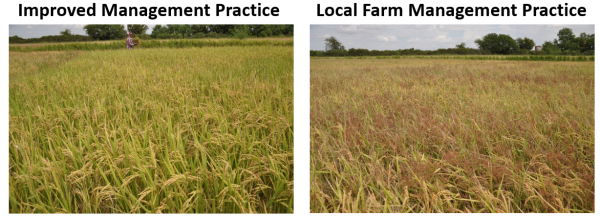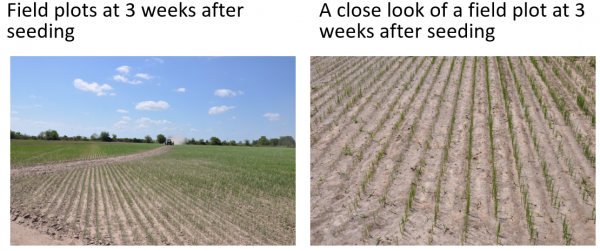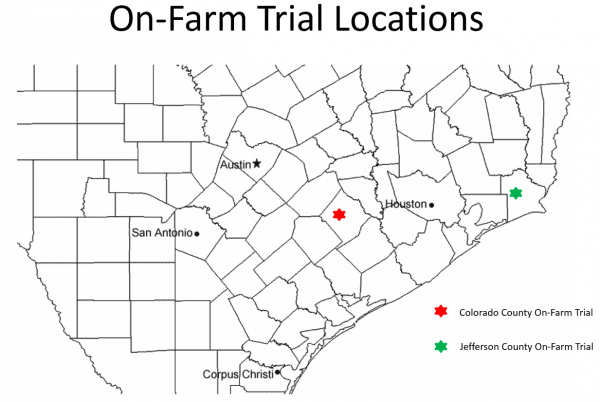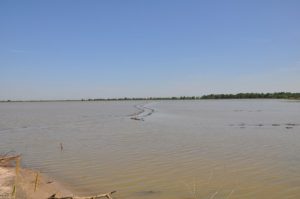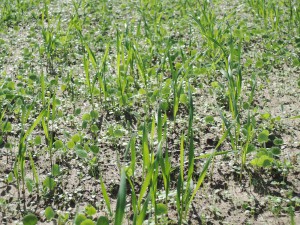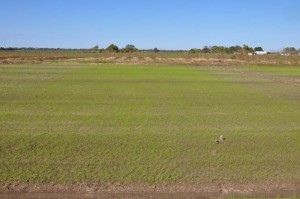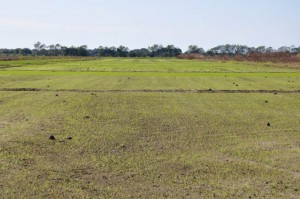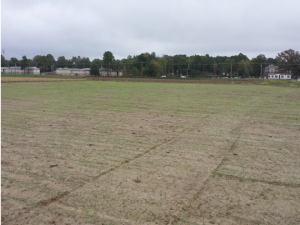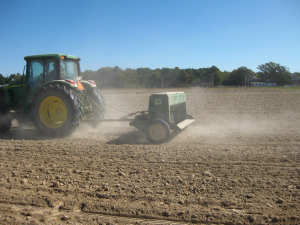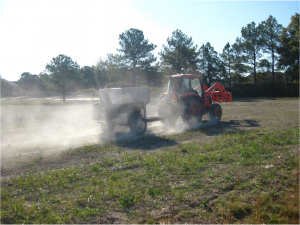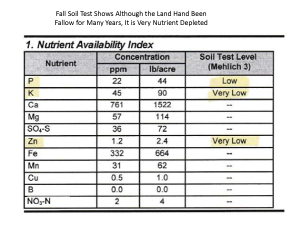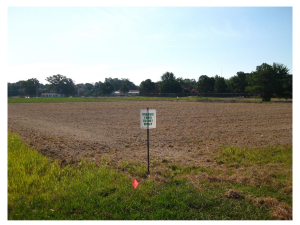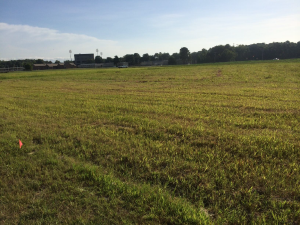Aqua
Main color:
Hover:
Active:
Title:
Title Hover:
Title Active:
News and Updates
9/18/2018
There are some dramatic differences between the improved management practice and the local farm management practice. The improved management practice treatment significantly increased stand at the seedling stage, suppressed weeds and narrow brown leaf spot at maturity, and increased grain yield compared to the local farm management practice treatment. Below you can see pictures of the improved management plot and the local farm management plot side by side – the pictures really show these differences!
9/16/2018
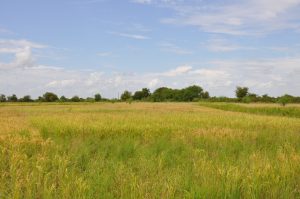 Colorado County is hot in the summer, with highs in the upper 90’s in the summer. The winters are mild, with lows around 40 degrees. It rains throughout the year there, with an annual precipitation of 43.89 inches. Each month between 3 and 5 inches of rain falls. In the next couple posts I’ll include more pictures from the Colorado County on-farm Trials to help you visualize the set-up and findings. First I’ll include a picture to the right of what the on-farm trial looked like at harvest, with the full plot layout outlined.
Colorado County is hot in the summer, with highs in the upper 90’s in the summer. The winters are mild, with lows around 40 degrees. It rains throughout the year there, with an annual precipitation of 43.89 inches. Each month between 3 and 5 inches of rain falls. In the next couple posts I’ll include more pictures from the Colorado County on-farm Trials to help you visualize the set-up and findings. First I’ll include a picture to the right of what the on-farm trial looked like at harvest, with the full plot layout outlined.
9/12/2018
Today we’ll provide a little more information about the Colorado County on-farm trial. This used a dry, drill seeding production system. There were two treatments with four reps per plots (each of 40 by 80 ft in size). We included an improved management practice, with the rice varietal Jasmine 85 planted at 120 lb/A. The seeds in this trial were treated with gibberellic acid and Sonata biofungicide (Bacillus pumilus). We also included the local farm management: Jazzman planted at 120 lb/A. The trial was planted along with the farmer’s planting on May 15th, 2018. In the photos below you can see what the field plots looked like 3 weeks after seeding:
9/11/2018
In addition to our research we’ve been doing on-farm demonstration trials in Texas. We have two of these trials: one in Colorado County (West Houston Rice Area) with dry, drill seeding production systems, and another in Jefferson County (East Houston Rice Area) with water seeding production systems. Below is a map of the on-farm trial locations, with the Colorado location starred in red and the Jefferson County location starred in green. The distance between the two locations is 140 miles. Over the next few days we’ll look into each trial in depth and tell you a little about what has been taking place at each trial demonstration.
7/08/2018
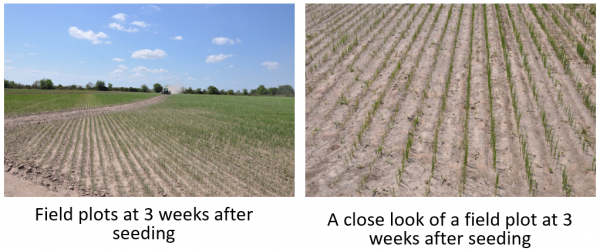 Today we’ll take a closer look at the Dry Drill Seeding On-Farm Trial in Colorado County, Texas. The pictures above show what the field plots looked like three weeks after planting. The first shows a broad view of the research field, while the second shows a close-up look at the plants. The Colorado County trial was planted along with farmer’s planting on May 16th, 2018. You can see some drastic differences between these plants and those that were water seeded!
Today we’ll take a closer look at the Dry Drill Seeding On-Farm Trial in Colorado County, Texas. The pictures above show what the field plots looked like three weeks after planting. The first shows a broad view of the research field, while the second shows a close-up look at the plants. The Colorado County trial was planted along with farmer’s planting on May 16th, 2018. You can see some drastic differences between these plants and those that were water seeded!
7/02/2018
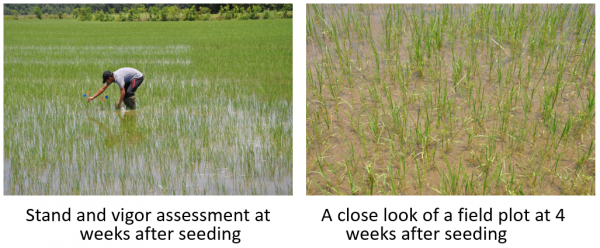 Hello again, loyal rice research update readers! Today we’re sharing more pictures from the water seeding on-farm trial in Jefferson County, Texas. The first picture is of one of our researchers doing an assessment for stand and vigor of the organic rice plants four weeks after seeding. The second is a close-up look at what the field plot looked like 4 weeks after seeding, with rice plants growing out of the flooded field.
Hello again, loyal rice research update readers! Today we’re sharing more pictures from the water seeding on-farm trial in Jefferson County, Texas. The first picture is of one of our researchers doing an assessment for stand and vigor of the organic rice plants four weeks after seeding. The second is a close-up look at what the field plot looked like 4 weeks after seeding, with rice plants growing out of the flooded field.
6/23/2018
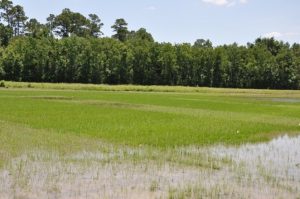 For the on-farm trials we used two different treatments:
For the on-farm trials we used two different treatments:
- Improved management treatment
- Dry seeding method: Planting of Jasmine 85 at 120 lbs/A (150% of recommended conventional seeding rate) with gibberellic acid (plant growth stimulator) and Sonata (Bacillus pumilus, a commercial bacterial biofungicide for organic agriculture use) seed treatment
- Water seeding method: Planting of Jasmine 85 at 120 lbs/A only
- Local farm management treatment
- Following farmer’s production practice (selection of rice variety and seeding rate, etc.)
Here is a picture from the water seeding on-farm trial in Jefferson County, Texas of the field plats at 4 weeks after the seeding.
6/14/2018
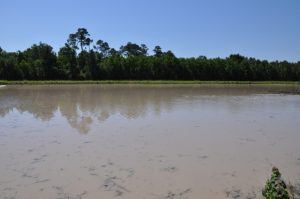 Our on-farm trials use two different planting methods: one is a Water Seeding On-Farm Trial in Jefferson County, Texas and the other is a Dry Drill Seeding On-Farm Trial in Colorado County, Texas. The water seeding trial is located in southeast Texas while the dry seeding trial in southwest Texas. There is approximately 150 miles between the two testing sites. The trial was planted along with the farmer’s planting via airplane broadcasting on May 8th, 2018. In this picture you can see what the site looked like when it the aerial seeding took place.
Our on-farm trials use two different planting methods: one is a Water Seeding On-Farm Trial in Jefferson County, Texas and the other is a Dry Drill Seeding On-Farm Trial in Colorado County, Texas. The water seeding trial is located in southeast Texas while the dry seeding trial in southwest Texas. There is approximately 150 miles between the two testing sites. The trial was planted along with the farmer’s planting via airplane broadcasting on May 8th, 2018. In this picture you can see what the site looked like when it the aerial seeding took place.
6/02/2018
We have some more updates from our research team, provided by Dr. Shane Zhou at the Texas A&M AgriLife Research in Beaumont, TX. First, I’ll share a picture from his team. This isn’t a lake – it’s a photo of the flooded farm fields one day before aerial seeding! The objectives of the on-farm trials portion of our research are to evaluate the performance of improved management treatment versus local farm management treatment on stand establishment, weed and disease suppression, plant growth, and grain yield and quality. We will also compare the performance of these treatments under two different planting methods (water seeding and dry drill planting). Stay tuned for information about the planting methods we’ll be using on the trials!
5/29/2018
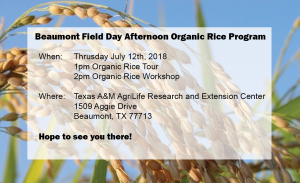 Missing our organic rice updates? Want to hear directly from the researchers? Interested in seeing some of the research we describe in person? If so, then come to this year’s Beaumont Field Day Afternoon Organic Rice Program, consisting of a field tour and workshop. The Organic Rice Tour will start at 1pm (after lunch) and be followed with the Organic Rice Workshop at 2pm. The project’s stakeholder advisory meeting will also be held with the afternoon program.
Missing our organic rice updates? Want to hear directly from the researchers? Interested in seeing some of the research we describe in person? If so, then come to this year’s Beaumont Field Day Afternoon Organic Rice Program, consisting of a field tour and workshop. The Organic Rice Tour will start at 1pm (after lunch) and be followed with the Organic Rice Workshop at 2pm. The project’s stakeholder advisory meeting will also be held with the afternoon program.
The 2018 Beaumont Field Day will be held on Thursday July 12th, 2018 at the Texas A&M AgriLife Research and Extension Center, 1509 Aggie Drive, Beaumont, TX 77713. We hope to see you there!
2/10/2018
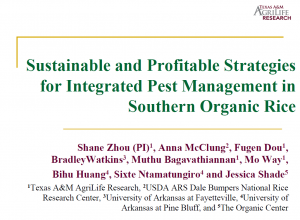 The advisory board for this project met on Friday, Feb. 9th to go over project updates and make comments and recommendations for the project. The objectives of the meeting were to provide the advisory board with an update on the project, share an outline of future research that could build on our findings, and collect input from the advisory board members. The agenda included an overall progress report, specific research and outreach activities happening in Arkansas, other research and outreach activities, information about a new proposal that will expand this research, and an open comment session. We are excited to share our update slides with you! You can download them here.
The advisory board for this project met on Friday, Feb. 9th to go over project updates and make comments and recommendations for the project. The objectives of the meeting were to provide the advisory board with an update on the project, share an outline of future research that could build on our findings, and collect input from the advisory board members. The agenda included an overall progress report, specific research and outreach activities happening in Arkansas, other research and outreach activities, information about a new proposal that will expand this research, and an open comment session. We are excited to share our update slides with you! You can download them here.
8/22/2017
 As we mentioned in our last post, Dr. Shane Zhou of Texas A&M AgriLife Research and Extension Center in Beaumont, Texas attended the 2017 American Phytopathological Society (APS) meeting, held in San Antonio, Texas, from August 5 -9, 2017. He presented a poster about our project, and also participated in a new component of the APS meeting: Idea Cafes. The purpose of Idea Cafes is to enhance your scientific content, find solutions to existing problems, discover innovative ideas in your area of research or outreach. It’s basically an opportunity for an in-depth round-table discussion on an area of interest, where great minds in plant pathology can meet in an informal setting. Dr. Zhou was invited by the APS meeting to organize and coordinate one of the Idea Cafes with the topic of “How to Combat Diseases in Organic Agriculture,” the first topic of its kind at the APS meeting. Dr. Zhou’s Idea Cafe session drew over a dozen participants interested in organic research and production, and included discussion on organic vegetables, rice, wheat and fruit trees.
As we mentioned in our last post, Dr. Shane Zhou of Texas A&M AgriLife Research and Extension Center in Beaumont, Texas attended the 2017 American Phytopathological Society (APS) meeting, held in San Antonio, Texas, from August 5 -9, 2017. He presented a poster about our project, and also participated in a new component of the APS meeting: Idea Cafes. The purpose of Idea Cafes is to enhance your scientific content, find solutions to existing problems, discover innovative ideas in your area of research or outreach. It’s basically an opportunity for an in-depth round-table discussion on an area of interest, where great minds in plant pathology can meet in an informal setting. Dr. Zhou was invited by the APS meeting to organize and coordinate one of the Idea Cafes with the topic of “How to Combat Diseases in Organic Agriculture,” the first topic of its kind at the APS meeting. Dr. Zhou’s Idea Cafe session drew over a dozen participants interested in organic research and production, and included discussion on organic vegetables, rice, wheat and fruit trees.
8/20/2017
 Dr. Shane Zhou, one of our project researchers from Texas A&M AgriLife Research and Extension Center in Beaumont, Texas attended the 2017 American Phytopathological Society (APS) meeting, held in San Antonio, Texas, in August 5 -9, 2017. The APS has more than 5,000 members from all the world, and its annual meeting attracts more than 1,500 international participants. Our project was featured as a poster presentation, entitled “Effects of seed treatment with biocontrol agents and gibberellic acid on seedling diseases, plant growth, yield, and quality in organic rice,” and drew many visitors during the meeting. In our next post we’ll be talking about the new Idea Cafes that were a part of the APS meeting!
Dr. Shane Zhou, one of our project researchers from Texas A&M AgriLife Research and Extension Center in Beaumont, Texas attended the 2017 American Phytopathological Society (APS) meeting, held in San Antonio, Texas, in August 5 -9, 2017. The APS has more than 5,000 members from all the world, and its annual meeting attracts more than 1,500 international participants. Our project was featured as a poster presentation, entitled “Effects of seed treatment with biocontrol agents and gibberellic acid on seedling diseases, plant growth, yield, and quality in organic rice,” and drew many visitors during the meeting. In our next post we’ll be talking about the new Idea Cafes that were a part of the APS meeting!
8/7/2017
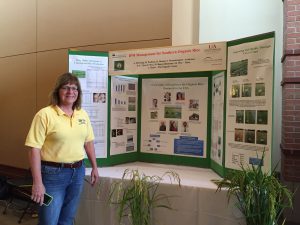 We recently presented more information about our project to the public, this time by our team member Dr. Anna McClung, Research Leader at the USDA Agricultural Research Service Dale Bumpers National Rice Research Center. The presentation took place on Aug. 4, 2017 at the annual Rice Expo, which was hosted by the University of Arkansas at the Grand Prairie Community Center in Stuttgart, AR. Dr. McClung presented a poster entitled “IPM Magagement for Southern Organic Rice”, featuring information from our organic rice project. She even included rice specimen, that you can see in the picture to the right! The event was attended by some 800 people and included poster displays and field tours of research plots.
We recently presented more information about our project to the public, this time by our team member Dr. Anna McClung, Research Leader at the USDA Agricultural Research Service Dale Bumpers National Rice Research Center. The presentation took place on Aug. 4, 2017 at the annual Rice Expo, which was hosted by the University of Arkansas at the Grand Prairie Community Center in Stuttgart, AR. Dr. McClung presented a poster entitled “IPM Magagement for Southern Organic Rice”, featuring information from our organic rice project. She even included rice specimen, that you can see in the picture to the right! The event was attended by some 800 people and included poster displays and field tours of research plots.
7/24/2017
 One of our project Principal investigators, Dr. M.O. (Mo) Way, Professor of Entomology, Texas AgriLife Research & Extension Center, just had an article published in the Rice Advocate about the 70th Texas A&M AgriLife Research and Extension Center Field Day that took place on July 13th, 2017. If you want to see more pictures and learn more about the event check out the Rice Advocate archive here, and scroll down to the “Texas Rice Update”. Some of the highlights include information about all of the speakers at the event, scrumptious details about the barbecue lunch, and of course, the organic rice tour and workshop.
One of our project Principal investigators, Dr. M.O. (Mo) Way, Professor of Entomology, Texas AgriLife Research & Extension Center, just had an article published in the Rice Advocate about the 70th Texas A&M AgriLife Research and Extension Center Field Day that took place on July 13th, 2017. If you want to see more pictures and learn more about the event check out the Rice Advocate archive here, and scroll down to the “Texas Rice Update”. Some of the highlights include information about all of the speakers at the event, scrumptious details about the barbecue lunch, and of course, the organic rice tour and workshop.
7/18/2017
Here are some pictures from the Workshop and Stalkerholder Meeting that we held at the 70th Annual Texas A&M AgriLife Research Rice Field Day. We covered disease management and research updates from Texas, information about nutrients and agronomy, weed management, insect management, updates from Arkansas and South Carolina, details about our outreach program (including this website!), an update on our cost-benefit analysis and plenty of time for questions. See our afternoon organic rice program flyer for more information.


7/16/2017
The 70th Annual Texas A&M AgriLife Research Rice Field Day took place on July 13, 2017 in Beaumont, Texas and was a resounding success! We held an Organic Rice Field Tour, Workshop, and Stakeholder Advisory Board Meeting as part of the Field day and had great attendance. We’ll start with pictures from the Field Tour, which had 30 people attending it.


6/28/2017
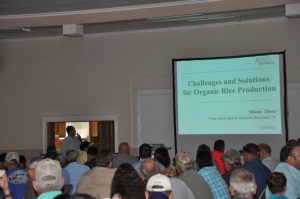 On June 27, 2017 our project had a strong presence at the 43rd Annual Rice Field Day at the David R. Wintermann Rice Research Station, Eagle Lake, Texas. We presented a research poster (download a pdf of the poster here!), and gave two invited talks highlighting challenges and solutions for organic rice production (by Dr. Xin-Gen (Shane) Zhou of Texas A&M AgriLife Research, Beaumont, TX), and the effect of seeding rate on organic rice production (by Dr. Fugen Dou of Texas A&M AgriLife Research, Beaumont, TX). This was the first time we’ve been invited to give talks on organic rice production and management at a rice field day organized by the Texas Rice Industry, indicating the increasing importance of organic rice production in the industry. There were more than 160 attendees, and most of them were rice farmers. Hopefully this is helping get the word out about new solutions and opportunities for rice farmers who might be interested in converting to organic! You can download an update about the Organic Rice Production Presentations at the field day here.
On June 27, 2017 our project had a strong presence at the 43rd Annual Rice Field Day at the David R. Wintermann Rice Research Station, Eagle Lake, Texas. We presented a research poster (download a pdf of the poster here!), and gave two invited talks highlighting challenges and solutions for organic rice production (by Dr. Xin-Gen (Shane) Zhou of Texas A&M AgriLife Research, Beaumont, TX), and the effect of seeding rate on organic rice production (by Dr. Fugen Dou of Texas A&M AgriLife Research, Beaumont, TX). This was the first time we’ve been invited to give talks on organic rice production and management at a rice field day organized by the Texas Rice Industry, indicating the increasing importance of organic rice production in the industry. There were more than 160 attendees, and most of them were rice farmers. Hopefully this is helping get the word out about new solutions and opportunities for rice farmers who might be interested in converting to organic! You can download an update about the Organic Rice Production Presentations at the field day here.
6/12/2017
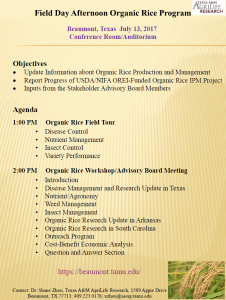 It’s that time of year again – we are planning for the next field day focusing on rice, where we will feature information about our project. For those of you interested in learning more about our organic rice IPM project, we invite you to attend the Texas A&M AgriLife Research Rice Field Day on July 13, 2017 in Beaumont, Texas. The afternoon will feature information about our organic rice program, with the objectives of providing updated information about organic rice production and management, reporting on the progress of our project, and getting input from our stakeholder advisory board. We’ll also be giving an organic rice field tour to talk about disease control, nutrient management, insect control, and variety performance. Field tours will be followed by an organic rice workshop and an advisory board meeting for our project. The workshop will cover disease management and research updates from Texas, information about nutrients and agronomy, weed management, insect management, updates from Arkansas and South Carolina, details about our outreach program (including this website!), an update on our cost-benefit analysis and plenty of time for questions. See our afternoon organic rice program flyer, or contact Dr. Shane Zhou (xzhou@aesrg.tamu.edu) for more information.
It’s that time of year again – we are planning for the next field day focusing on rice, where we will feature information about our project. For those of you interested in learning more about our organic rice IPM project, we invite you to attend the Texas A&M AgriLife Research Rice Field Day on July 13, 2017 in Beaumont, Texas. The afternoon will feature information about our organic rice program, with the objectives of providing updated information about organic rice production and management, reporting on the progress of our project, and getting input from our stakeholder advisory board. We’ll also be giving an organic rice field tour to talk about disease control, nutrient management, insect control, and variety performance. Field tours will be followed by an organic rice workshop and an advisory board meeting for our project. The workshop will cover disease management and research updates from Texas, information about nutrients and agronomy, weed management, insect management, updates from Arkansas and South Carolina, details about our outreach program (including this website!), an update on our cost-benefit analysis and plenty of time for questions. See our afternoon organic rice program flyer, or contact Dr. Shane Zhou (xzhou@aesrg.tamu.edu) for more information.
5/12/2017
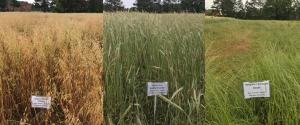 Here are more interesting results from our cover crop trials during the winter of 2016-2017 at Pine Bluff, AR:
Here are more interesting results from our cover crop trials during the winter of 2016-2017 at Pine Bluff, AR:
- Drainage furrows were included in the field at planting. However, crimson clover was not successful in establishment, perhaps due to wet winter soils and the tall dense canopy of grass crops planted. To allow the clover to be more successful, one may need a lower seeding rate of grass crop.
- Very little weed pressure was observed due to the dense grass cover crop canopy. Soil samples taken prior to cover crop termination will be used to determine the presence and diversity of weeds in the seed bed.
- Nutrient analysis of the cover crop forage and the soil prior to and after incorporation of are pending.
5/8/2017
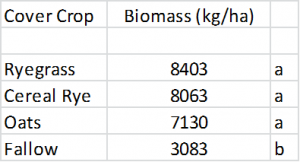
Means of 4 field replications. Means followed by the same letter are not significantly different.
We’re excited to share some of our results from our cover crop trials during the winter of 2016-2017 at Pine Bluff, AR! We found that there was no statistical difference in biomass produced among the three planted cover crops. However, they all produced more biomass for plowdown than leaving the field fallow. In the graph to the right you can see the mean biomass from the five different field trials. The different letters show significant differences between groups. Note that only the fallow group is different from the other groups. While the biomass averages weren’t significantly different, we did observe lodging (plant bending over) for ryegrass after heading, which could be an extra benefit in weed suppression. Next, we will conduct a field study to determine if the different Winter 2016-17 cover crops result in differences in weed pressure in summer 2017.
4/25/2017
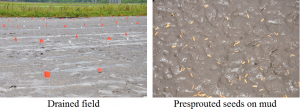 After water seeding the organic rice field sites, Dr. Shane Zhou’s lab in Beaumont, TX drains the field. Draining the field after water seeding helps promote the growth of radicles and avoids damage caused by ducks. Radicles are the part of the rice embryo that develop into roots, so ensuring that they have rapid and healthy growth is key to future success of the rice crop. Avoiding duck damage is also key. Wild ducks can land on the flooded field and stir up mud in the water. This dirty water blocks sunlight from penetrating the water and reaching the seed, which can kill the rice crop. Ducks can also cause substantial damage later in the season, when they sometimes pull pull up rice shoots and chew the rice seeds off the bottom of the shoot. In the pictures to the right, you can see the Beaumont field site after it has been drained, and a close-up of the pre-sprouted seeds in the mud.
After water seeding the organic rice field sites, Dr. Shane Zhou’s lab in Beaumont, TX drains the field. Draining the field after water seeding helps promote the growth of radicles and avoids damage caused by ducks. Radicles are the part of the rice embryo that develop into roots, so ensuring that they have rapid and healthy growth is key to future success of the rice crop. Avoiding duck damage is also key. Wild ducks can land on the flooded field and stir up mud in the water. This dirty water blocks sunlight from penetrating the water and reaching the seed, which can kill the rice crop. Ducks can also cause substantial damage later in the season, when they sometimes pull pull up rice shoots and chew the rice seeds off the bottom of the shoot. In the pictures to the right, you can see the Beaumont field site after it has been drained, and a close-up of the pre-sprouted seeds in the mud.
4/20/2017
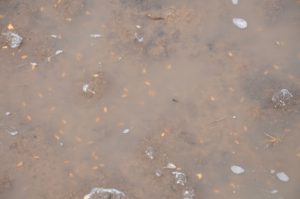 This is another picture from Dr. Shane Zhou’s lab in Beaumont, TX looking at the water seeding of their organic rice field sites. Here you can see the pre-sprouted seeds after they have been broadcasted into the field, which is flooded with about a half-inch of water. Water seeding causes the pre-sprouted rice seeds to be deposited on the soil surface under the water. Water seeding is most successful in areas where water levels can be controlled, and the field can be drained and flooded as needed. The next step in the planting of our organic field trials is draining the field, so you can see why being able to control the water level is important!
This is another picture from Dr. Shane Zhou’s lab in Beaumont, TX looking at the water seeding of their organic rice field sites. Here you can see the pre-sprouted seeds after they have been broadcasted into the field, which is flooded with about a half-inch of water. Water seeding causes the pre-sprouted rice seeds to be deposited on the soil surface under the water. Water seeding is most successful in areas where water levels can be controlled, and the field can be drained and flooded as needed. The next step in the planting of our organic field trials is draining the field, so you can see why being able to control the water level is important!
4/19/2017
 As we continue to learn more about the organic rice seeding process from Dr. Shane Zhou’s lab in Beaumont, TX, it’s time to move on to the seeding phase. After the seeds have been pre-sprouted they are ready to go out into the field! You can see from the pictures to the right that the seeding we did takes place in flooded fields. This is called water seeding. The way water seeding works is that the rice seeds that were pre-sprouted get broadcased into a field that has been flooded with about a half-inch of water. You can see members of Dr. Zhou’s lab in this picture spreading the seeds that they’ve been working with into the field test plots.
As we continue to learn more about the organic rice seeding process from Dr. Shane Zhou’s lab in Beaumont, TX, it’s time to move on to the seeding phase. After the seeds have been pre-sprouted they are ready to go out into the field! You can see from the pictures to the right that the seeding we did takes place in flooded fields. This is called water seeding. The way water seeding works is that the rice seeds that were pre-sprouted get broadcased into a field that has been flooded with about a half-inch of water. You can see members of Dr. Zhou’s lab in this picture spreading the seeds that they’ve been working with into the field test plots.
4/17/2017
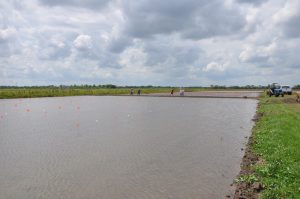 Before we show pictures of the organic rice plantings done at the Beaumont, TX Testing Site by Dr. Shane Zhou’s lab, let’s take a look at the field trial location at the Beaumont site. This picture gives an overview of the full Beaumont organic rice field site where we planted out our trials. In the front of the picture is where the cover crop trials are located. The middle-ground of the photo is where the seed treatment trials are planted, and in the back part of the picture is where the variety trials are located. You can see some of Dr. Zhou’s lab members in this photo getting ready for seeding!
Before we show pictures of the organic rice plantings done at the Beaumont, TX Testing Site by Dr. Shane Zhou’s lab, let’s take a look at the field trial location at the Beaumont site. This picture gives an overview of the full Beaumont organic rice field site where we planted out our trials. In the front of the picture is where the cover crop trials are located. The middle-ground of the photo is where the seed treatment trials are planted, and in the back part of the picture is where the variety trials are located. You can see some of Dr. Zhou’s lab members in this photo getting ready for seeding!
4/15/2017
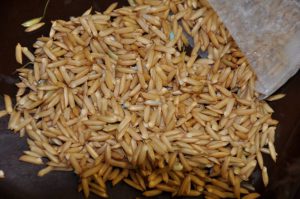 Let’s continue with the information from Dr. Shane Zhou’s lab in Beaumont, TX about getting seeds ready for planting. After soaking the seeds for 24 hours, and then keeping the seeds in an incubator for 20 hours, the germinated seeds are ready for water seeding. In the picture to the right you can see the seeds once they are removed from the mesh bag. These seeds have imbibed water from the soaking, and need to be planted right away for best results. The main benefit of pre-sprouting rice seeds is that, because they have already imbibed water, they have a higher seed weight and improved initiation of germination. Additionally, injury from rice seed midges can be worse when you seed dry seeds.
Let’s continue with the information from Dr. Shane Zhou’s lab in Beaumont, TX about getting seeds ready for planting. After soaking the seeds for 24 hours, and then keeping the seeds in an incubator for 20 hours, the germinated seeds are ready for water seeding. In the picture to the right you can see the seeds once they are removed from the mesh bag. These seeds have imbibed water from the soaking, and need to be planted right away for best results. The main benefit of pre-sprouting rice seeds is that, because they have already imbibed water, they have a higher seed weight and improved initiation of germination. Additionally, injury from rice seed midges can be worse when you seed dry seeds.
4/13/2017
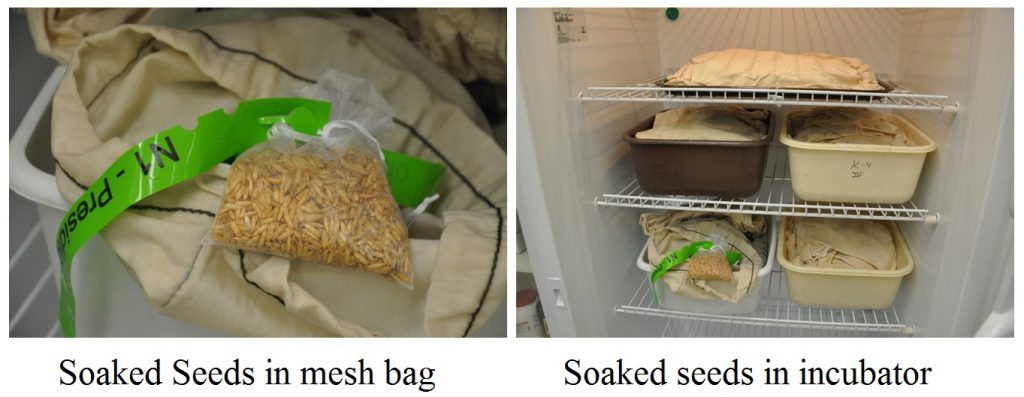
Now we’ll revisit the organic rice plantings at the Beaumont Testing Site, with some information from Dr. Shane Zhou about how they treat their seeds before planting. In the pictures above you can see how the lab helps shepherd sprouting: first, they soak the seeds in a mesh bag in the greenhouse for 24 hours. Then, they drain the mesh bags and place the soaked seeds in the incubator at 30 degrees C for 20 hours.
4/11/2017
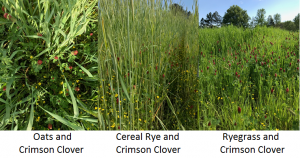 Here is another update from Dr. Anna McClung at the Pine Bluff, AR organic rice field sites. This one looks closely at the heading of our winter cover crops. Heading is when plants form flowers in preparation for seeds. Most cover crops must be killed – usually they are turned into the soil as green manure – before the flower heads turn to seed, because those seeds can become weeds when you are trying to grow your target crop. You can see from the pictures to the right of the oats and crimson clover (left), cereal rye and crimson clover (middle), and ryegrass and crimson clover (right) that we are seeing heading in all of our winter cover crop trials. Soon they will be incorporated into the soil and rice planting can begin!
Here is another update from Dr. Anna McClung at the Pine Bluff, AR organic rice field sites. This one looks closely at the heading of our winter cover crops. Heading is when plants form flowers in preparation for seeds. Most cover crops must be killed – usually they are turned into the soil as green manure – before the flower heads turn to seed, because those seeds can become weeds when you are trying to grow your target crop. You can see from the pictures to the right of the oats and crimson clover (left), cereal rye and crimson clover (middle), and ryegrass and crimson clover (right) that we are seeing heading in all of our winter cover crop trials. Soon they will be incorporated into the soil and rice planting can begin!
4/5/2017
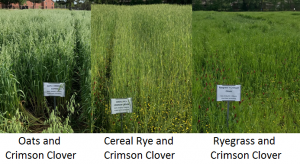 Now it’s time for an update from Dr. Anna McClung on the Winter 2016/2017 Cover Crops at our Pine Bluff, AR organic rice field sites. The cover crops we have been testing include combinations of oats and crimson clover, cereal rye and crimson clover, and ryegrass and crimson clover. All of the winter cover crops have seen good growth over the winder. In this picture, you can see the growth of our oats and crimson clover on the far left, followed by the cereal rye and crimson clover in the middle picture, with the ryegrass and crimson clover on the right.
Now it’s time for an update from Dr. Anna McClung on the Winter 2016/2017 Cover Crops at our Pine Bluff, AR organic rice field sites. The cover crops we have been testing include combinations of oats and crimson clover, cereal rye and crimson clover, and ryegrass and crimson clover. All of the winter cover crops have seen good growth over the winder. In this picture, you can see the growth of our oats and crimson clover on the far left, followed by the cereal rye and crimson clover in the middle picture, with the ryegrass and crimson clover on the right.
3/10/2017
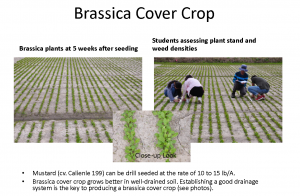 For those of you interested in growing organic rice, or even those of you interested in using ryegrass or brassica cover crops, the researchers at the Beaumont, TX field testing site put together some slides from a past presentation that can provide useful tips for planning your plantings. They include things like how to plant cover crops, how irrigation and drainage should be managed, and when the cover crops need to be incorporated back into the soil to maximize their benefit without adding weed seeds into the field that could cause problems later on. You can download a pdf of the slides here!
For those of you interested in growing organic rice, or even those of you interested in using ryegrass or brassica cover crops, the researchers at the Beaumont, TX field testing site put together some slides from a past presentation that can provide useful tips for planning your plantings. They include things like how to plant cover crops, how irrigation and drainage should be managed, and when the cover crops need to be incorporated back into the soil to maximize their benefit without adding weed seeds into the field that could cause problems later on. You can download a pdf of the slides here!
3/7/2017
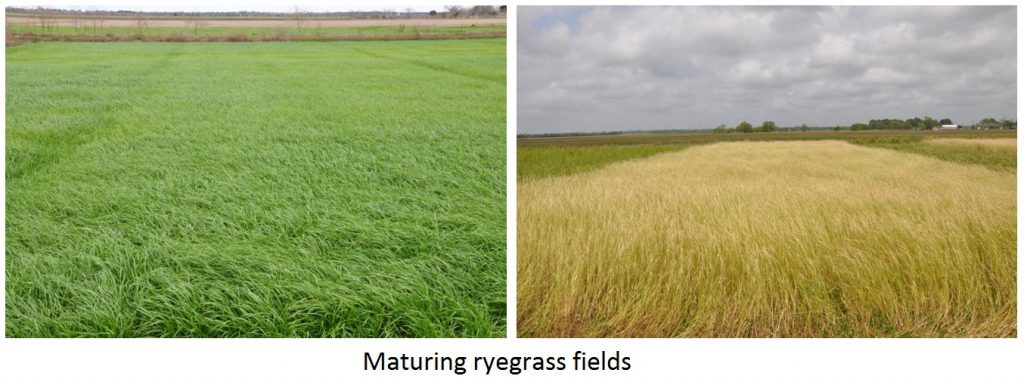
Ryegrass cover crop should be terminated by incorporating them into the soil before they set seed to get the maximum above-ground biomass while avoiding the production of seeds that could become a weed problem in future seasons. Ryegrass can produce more than 4,000 lb/acre of dry abover-ground biomass in southeast Texas – quite a haul!
3/2/2017
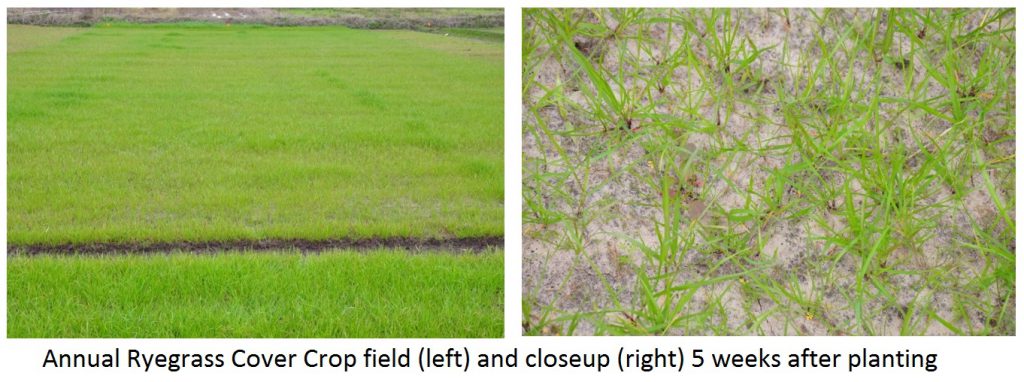
These are pictures of our organic ryegrass cover crop on our rice fields at Beaumont, TX five weeks after the crop was planted. Like brassicas, having a good drainage system is critical for the establishment and growth of ryegrass cover crops. In the picture to the left above you can see a drainage ditch cutting through the field. Annual ryegrass is one of most successful winter cover crops in southeast Texas, as it grows quickly and can control weeds well.
2/25/2017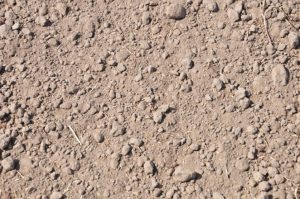 In addition to mustard (brassica) cover crops, we also looked at an annual ryegrass cover crop at our organic rice field sites in Beaumont, TX. Ryegrass is spread by broadcasting the seeds onto a prepared bed. The picture to the right shows the soil after the ryegrass seed has been spread. Here are some tips on how to manage a ryegrass cover crop for organic rice fields from our researchers:
In addition to mustard (brassica) cover crops, we also looked at an annual ryegrass cover crop at our organic rice field sites in Beaumont, TX. Ryegrass is spread by broadcasting the seeds onto a prepared bed. The picture to the right shows the soil after the ryegrass seed has been spread. Here are some tips on how to manage a ryegrass cover crop for organic rice fields from our researchers:
- Annual ryegrass can be broadcast planted at the rate of 45 lb/acre.
- October and November are its optimum planting dates.
- No irrigation is needed for the germination and growth of ryegrass. Its growth can solely depend on rainfalls.
2/20/2017

Mustard (brassica) can make great cover crop plants, but they are also notorious weeds. How can a farmer get the maximum benefit from the cover crop without adding thousands of seeds to the weed seedbank? The trick is to make sure the brassica plants don’t get to the stage where they have mature seeds. Brassica cover crops should be terminated by incorporating them into the soil (see photo above) before seed set to get the maximum aboveground biomass but avoid the production of seeds that could become a weed problem in future seasons. Stay tuned for information about our annual rygrass cover crop!
2/17/2017
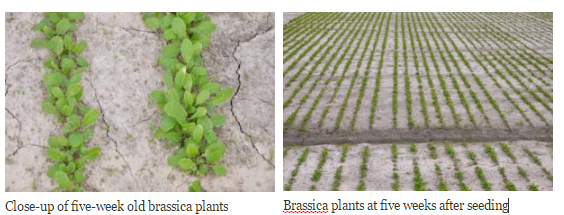
Here is a photo of the field where we planted the mustard (brassica) cover crop five weeks after seeding in our Beaumont Testing Site. Next to it is a close up of the brassica plants. You can see that they are starting to become established. Next we’ll look at how to keep the mustard plants from becoming weeds!
2/16/2017
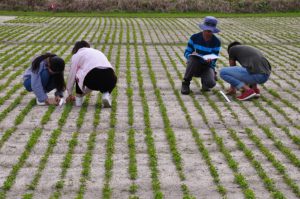 If you decide to drill seed your mustard (brassica) cover crop instead of broadcasting it, it is important to get the drill seeding rate correct. This specific mustard cover crop (cv. Caliente 199) can be drill seeded at the rate of 10 to 15 pounds per acre. It is also important to make sure the soil is right for brassicas. Brassica cover crops grow best in well-drained soil, so establishing a good drainage system is key to producing a healthy brassica cover crop. In this photo you can see students assessing plant stand of the cover crop and weed densities. The brassica plants in this photo are taken five weeks after seeding. You can also see that the soil is not muddy or bogged down with water. This is because drainage was taken into account before seeding.
If you decide to drill seed your mustard (brassica) cover crop instead of broadcasting it, it is important to get the drill seeding rate correct. This specific mustard cover crop (cv. Caliente 199) can be drill seeded at the rate of 10 to 15 pounds per acre. It is also important to make sure the soil is right for brassicas. Brassica cover crops grow best in well-drained soil, so establishing a good drainage system is key to producing a healthy brassica cover crop. In this photo you can see students assessing plant stand of the cover crop and weed densities. The brassica plants in this photo are taken five weeks after seeding. You can also see that the soil is not muddy or bogged down with water. This is because drainage was taken into account before seeding.
2/15/2017
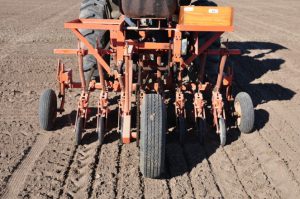 Our next series of photos will look at the 2016-2017 Winter Cover Crop Trials at the Beaumont Testing Site. This first photo shows the drill planting of mustard into the field. Mustard cover crops (Brassica) can either be drill seeded, as pictured here, or broadcasted over well-pfepared seedbeds. Selecting the right planting date is key to producing a successful brassica cover crop. In southeast Texas, mid-November is the optimum planting date for a winter brassica cover crop, because the cool temperature in November is good for the growth of the brassica crop, but not favorable for the growth of weeds.
Our next series of photos will look at the 2016-2017 Winter Cover Crop Trials at the Beaumont Testing Site. This first photo shows the drill planting of mustard into the field. Mustard cover crops (Brassica) can either be drill seeded, as pictured here, or broadcasted over well-pfepared seedbeds. Selecting the right planting date is key to producing a successful brassica cover crop. In southeast Texas, mid-November is the optimum planting date for a winter brassica cover crop, because the cool temperature in November is good for the growth of the brassica crop, but not favorable for the growth of weeds.
2/14/2017
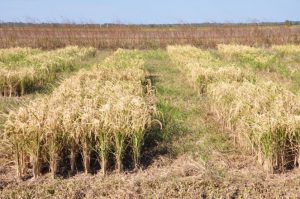 After the rice plants have flowered the rice grains mature to the point where they are ready to harvest, as you can see in this picture from our Beaumont Testing Site. Our research team harvested the rice using a plot combine once it reached maturity. This harvesting took place ten days after the field was drained. We measured the grain yield and moisture, and the rice yields were adjusted to 12% moisture content. We also examined milling quality, the percentage head rice and the percentage total rice.
After the rice plants have flowered the rice grains mature to the point where they are ready to harvest, as you can see in this picture from our Beaumont Testing Site. Our research team harvested the rice using a plot combine once it reached maturity. This harvesting took place ten days after the field was drained. We measured the grain yield and moisture, and the rice yields were adjusted to 12% moisture content. We also examined milling quality, the percentage head rice and the percentage total rice.
2/10/2017
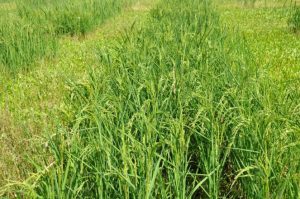 Here is a picture of the rice with floral heads. Because rice are in the grass family, they don’t have showy blooms that you would typically think of when envisioning flowers. Instead, they have spikelets, which are composed of two bracts called glumes, and one or more florets. A floret includes the rice flower, as well as two bracts that surround the flower: an external one, called a lemma, and an internal one called the palea. In rice, there are several stages of flowering. First, there is the stage prior to the opening of the spikelet, where the tip of the lemma and palea just begin to open. Then, once they have reached their maximum opening, the anthers (male parts of the flower) elongate. After that, the spikelet closes and the anthers come out, scattering the pollen into the wind. Finally, the anthers are left outside to wither, while the plant moves on to the next step of reproduction: fertilization!
Here is a picture of the rice with floral heads. Because rice are in the grass family, they don’t have showy blooms that you would typically think of when envisioning flowers. Instead, they have spikelets, which are composed of two bracts called glumes, and one or more florets. A floret includes the rice flower, as well as two bracts that surround the flower: an external one, called a lemma, and an internal one called the palea. In rice, there are several stages of flowering. First, there is the stage prior to the opening of the spikelet, where the tip of the lemma and palea just begin to open. Then, once they have reached their maximum opening, the anthers (male parts of the flower) elongate. After that, the spikelet closes and the anthers come out, scattering the pollen into the wind. Finally, the anthers are left outside to wither, while the plant moves on to the next step of reproduction: fertilization!
2/7/2017
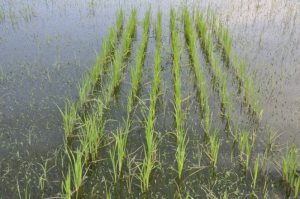
Flooded rice plots (Beaumont, TX)
Here is another picture of the organic rice research plots at the Beaumont Testing Site. This one shows the flooded organic rice plots. Permanent flood in the plots was established when the rice plants had sprouted two leaves (at the 2-leaf stage), so that we could control weeds like grasses that are common in rice fields. This flooding happened early in the life-cycle of the plant, which is critical for organic plots, because it is one of the key tools to successfully control weeds at early stages in the organic rice production system. Weeds are one of the major challenges for organic rice production. No synthetic herbicides are allowed to use for the control of weeds in organic systems, so organic growers need to use other tools to help prevent weeds from out-competing the organic crops.
1/30/2017
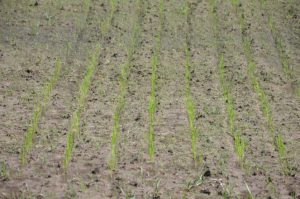
Organic Presidio variety rice seedlings at the Beaumont Testing Site
Now we’ll review how the organic rice research plots at the Beaumont Testing Site have done over the last year. We’ll start with this photo of the rice seedlings. This is the Presidio variety of rice, which was drill seeded at a rate of 120 lb/acre. Organic seeds are usually planted at a higher density than conventional seeds (150% of the seeding rate for conventional rice), because it has higher mortality rate due to increased pressure from pests and weeds. This increased seeding rate is helpful to improve stand establishment and suppress the growth of weeds in organic rice production systems.
1/19/2017

L to R: Dr. Mo Way, Dr. Miguel Ramiriz, Dr. Ricardo, Ana Vettorazzi and Ernesto Baron
We are always looking to expand our organic research and learn from international partners. Dr. Mo Way recently met 2 Cuban rice scientists, Dr. Miguel Ramiriz, Dr. Ricardo Polon, at a global trade show. They mentioned that they have noticed certain organically-based products which have activity against an array of rice insect pests. One of the products they mentioned is derived from citrus rind and the other is derived from arthropod exoskeleton (chitin). This piqued our interest, and so now we are reaching out to try to get the products to evaluate them. We’ll keep the site updated if we are able to test them and get interesting results, so stay tuned! This picture was taken near Havana, Cuba in November 2016 at a global trade show. The two people pictured who weren’t mentioned above (Ana and Ernesto) are with USA Rice Federation.
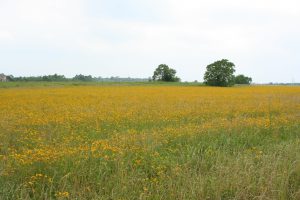 1/13/2017
1/13/2017
Here is a photo of a fallow field near Beaumont TX from one of this project’s researchers: Dr. Mo Way. Last growing season, the field was planted with organic rice, but now all you see are yellow-flowered plants. These plants are in the genus Coreopsis, which is in the sunflower Family (Asteraceae). The flowers are very attractive to honeybees. Dr. Way swept the field to see what kinds of insects he would find and he collected many honeybees foraging on the flowers.
01/10/2017
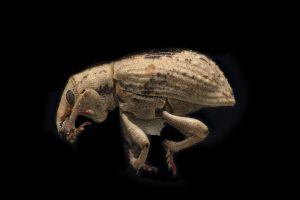
A rice water weevil
Photo Credit: Macroscopic Solutions
We have a new update from our researcher, Dr. M.O. (Mo) Way, a Professor of Entomology at the Texas AgriLife Research and Extension Center. Dr. Way and his team evaluated 2 organic materials to look at how effective they are at controlling the rice water weevil and other rice pests. What they found was that while the products weren’t effective against rice water weevils or stem borers, one of the products did appear to have some fungicidal effect on seedling rice diseases! These results are still preliminary, so we can’t divulge the names of the products yet, but stay tuned for more information on product efficacy as the study continues.
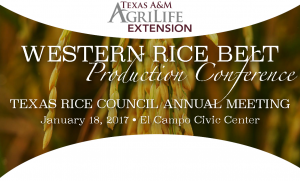 01/11/2017
01/11/2017
We hope everyone had a great holiday season! We’re back at work with our project, and will be presenting at the Texas A&M AgriLife Extension Western Rice Belt Production Conference, which will include the Texas Rice Council’s Annual Meeting. This takes place on January 18th, 2017 and El Campo Civic Center. We’ll hear from experts talking about weed control, rice disease management, financial risk management, rice market inventory, updates from the USA Rice, and more. We’ll also be showing posters of our preliminary results.
11/18/2016
Congratulations to our organic rice research team: The Beaumont Testing Site has been certified for organic rice production! This means that all rice produced on the field site using our organic experimental techniques will be certified organic. As all organic farmers know, getting organic certification is no simple task, so great job to our researchers for shepherding this through.
10/20/2016
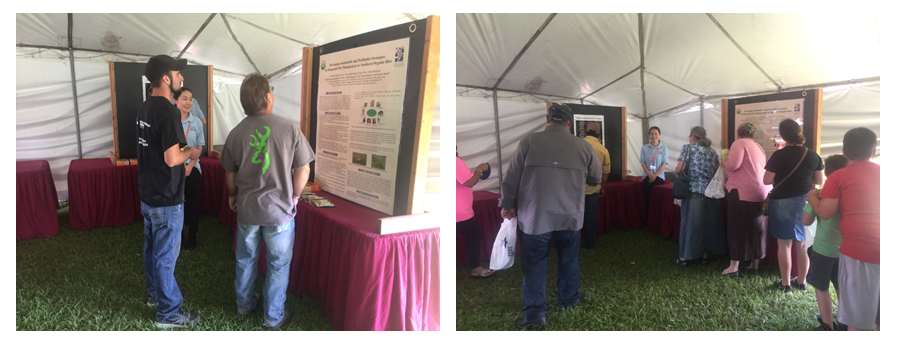
Here are the pictures of our poster at the Texas Rice Festival. You can see people crowded around it to take a look at information about our project. Over the course of the festival, hundreds of people came to visit our project’s poster introducing our organic rice IPM project. Our poster also included some preliminary results. Hopefully this increased interest in organic production of rice!
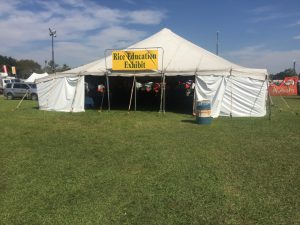 10/16/2016
10/16/2016
Here is another picture from the Texas Rice Festival which was held the first weekend of October. This one is of the Rice Education Tent, which was where our poster was exhibited. Other exhibits at the festival included an Antique Car Show, an Arts & Crafts Show, a Farm Equipment show, a Livestock Show, an Open Horse Show, and a Photography & Art Exhibit. There was a lot happening at the Texas Rice Festival! Next time we’ll post a picture of what you’ve all been waiting for: our poster on exhibit!
10/15/2016
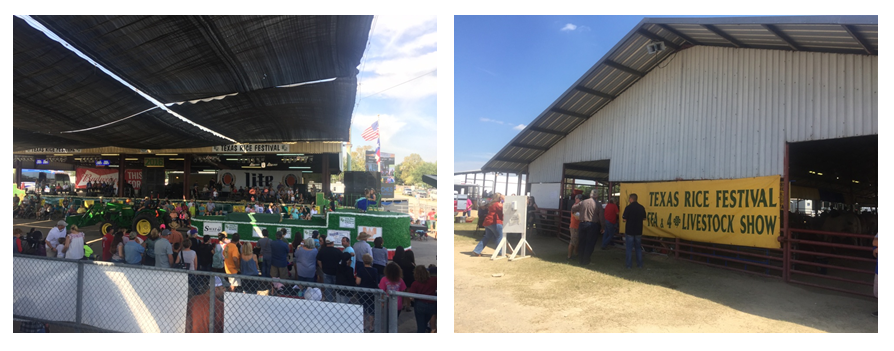
Here are the photos we promised from the rice festival! I’ll post a few more tomorrow as well. Enjoy!
10/07/2016
 Get ready for some rice festival photos! Didn’t know there was a whole festival dedicated to rice? Well, here is what you need to know about the Texas Rice Festival – an annual rice harvest celebration held the first weekend of October. The festival was created in 1969 to honor rice farming, which is a major economic contribution in the region of Southeast Texas. It’s held in the Winnie-Stowell Park in Winnie, Texas. This year was the 47th anniversary of the Texas Rice Festival, and it was held on Sept 28 – Oct 1, 2016. We’ll be posting a few pictures and updates from the event.
Get ready for some rice festival photos! Didn’t know there was a whole festival dedicated to rice? Well, here is what you need to know about the Texas Rice Festival – an annual rice harvest celebration held the first weekend of October. The festival was created in 1969 to honor rice farming, which is a major economic contribution in the region of Southeast Texas. It’s held in the Winnie-Stowell Park in Winnie, Texas. This year was the 47th anniversary of the Texas Rice Festival, and it was held on Sept 28 – Oct 1, 2016. We’ll be posting a few pictures and updates from the event.
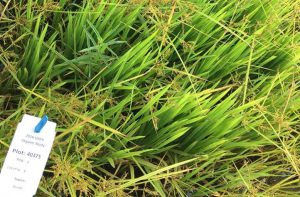 10/03/2016
10/03/2016
Jasmine 85 isn’t the only organic rice variety that is winning the fight against weeds such as nutsedge. This picture shows the variety Rondo, which looks similar to the Jasmine 85 variety in our previous post, but is a distinct variety with similar weed-competition qualities. Rondo, like Jasmine 85, shows some ability to compete with the weeds. One reason these varieties might be faring better than others when it comes to weed competition is that they have aggressive tillering, when shoots emerge from the bottom of the original rice stalks. Their large root masses could also be helping with weed competition.
09/29/2016
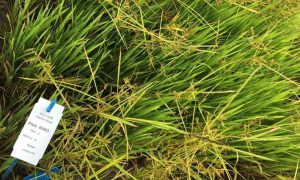
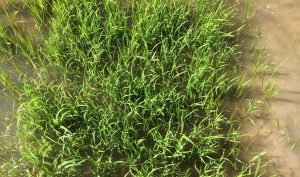 Some organic rice varieties do better than others when it comes to competing with weeds. For example, these pictures of Jasmine 85 show that they are not experiencing the same intensity of weed pressure as some of the other organic rice varieties.
Some organic rice varieties do better than others when it comes to competing with weeds. For example, these pictures of Jasmine 85 show that they are not experiencing the same intensity of weed pressure as some of the other organic rice varieties.
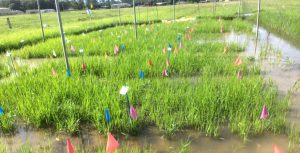 09/21/2016
09/21/2016
Here we take a closer look at some of the weeds that have sprouted up in our water seeded organic rice field trials. Unfortunately, as you can see from the picture, we are dealing with heavy nutsedge competition. While the rice is showing great emergency, the nutsedge weeds are also having strong emergence and are competing with our organic rice crop.
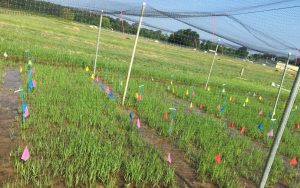 09/12/2016
09/12/2016
In addition to the cowpea trials, we have been examining our water seeded field trial closely. In this picture you can see the rice starting to emerge in the water seeded field trial plots, which are covered with bird netting. Unfortunately, despite the great emergence we are seeing in these organic rice plots, there are still some challenges that we are facing. Next post will highlight one of the major challenges that all organic rice growers must face: competition from nutsedge. We’ll also look at specific varieties to see how they are interacting with the many weed species that plague rice fields.
08/20/2016
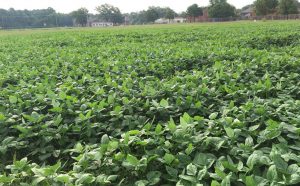
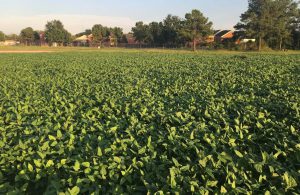
We have head excellent growth of the cowpea summer green manure crop. With its rapid emergence and establishment, these pictures show how green and lush the fields were by July 17th. The second picture is from July 28th, and shows how densely the copease have formed a groundcover.
08/15/2016
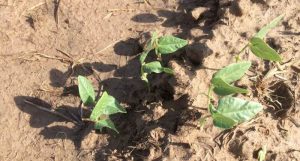
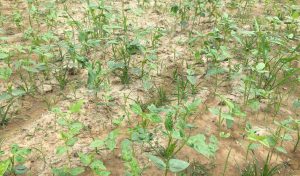 Wondering what the cowpea green manure crop looks like when it emerges? Here is a picture of the cowpeas as they sprout from the soil, followed by a picture of the cowpeas as they get established, along with emerging nutsedge.
Wondering what the cowpea green manure crop looks like when it emerges? Here is a picture of the cowpeas as they sprout from the soil, followed by a picture of the cowpeas as they get established, along with emerging nutsedge.
08/08/2016
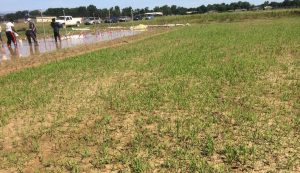 It’s time to check in on some of the other field trials that are happening in our research project. One trial that is taking place at Pine Bluff looks at using green manure as a type of soil amendment. Green manure is a way to enhance the nutrients in the field by growing a crop that will be incorporated back into the soil. In this trial we will be using cowpeas as our green manure crop. In this picture the foreground shows the area that will be planted as the summer green manure crop. These sites will be the location of our 2017 organic rice field trials.
It’s time to check in on some of the other field trials that are happening in our research project. One trial that is taking place at Pine Bluff looks at using green manure as a type of soil amendment. Green manure is a way to enhance the nutrients in the field by growing a crop that will be incorporated back into the soil. In this trial we will be using cowpeas as our green manure crop. In this picture the foreground shows the area that will be planted as the summer green manure crop. These sites will be the location of our 2017 organic rice field trials.
08/05/2016
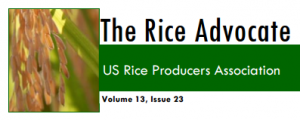 For those of you who don’t follow the Rice Advocate, one of our research team members, Dr. MO Way, recently had an article published. In it he describes the outcomes of the 2016 Rice Market & Technology Convention. He notes that as of yet there are no effective organically-approved insecticides for rice water weevil, one of the top insect pests of organic rice. One of the reasons that organic rice is so susceptible to the rice water weevil is that it is much smaller at the time of weevil attack compared to conventional rice. Fostering a good stand of organic rice can dilute rice water weevil pressure, so increasing seeding rate and planting when weather is warm to encourage rapid growth and a good stand are sound cultural practices to combat rice water weevil. You can view the full article here on page 4!
For those of you who don’t follow the Rice Advocate, one of our research team members, Dr. MO Way, recently had an article published. In it he describes the outcomes of the 2016 Rice Market & Technology Convention. He notes that as of yet there are no effective organically-approved insecticides for rice water weevil, one of the top insect pests of organic rice. One of the reasons that organic rice is so susceptible to the rice water weevil is that it is much smaller at the time of weevil attack compared to conventional rice. Fostering a good stand of organic rice can dilute rice water weevil pressure, so increasing seeding rate and planting when weather is warm to encourage rapid growth and a good stand are sound cultural practices to combat rice water weevil. You can view the full article here on page 4!
08/03/2016
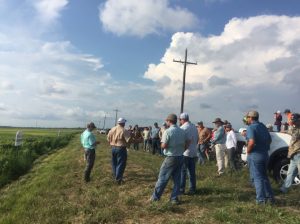 We recently represented our project team at a field day hosted by RiceTech in Nome, TX, a commercial hybrid rice company developing and marketing hybrid rice. We brought 7 students to the RiceTech field tour, followed by dinner at the Winnie’s Community Center after the tour. There were about 30 people attending the dinner, including eight from our Center. Two RiceTech employees talked about the performance of XL753, XL723 and XL760 in comparisons with Presidio and Cheniere. One leading breeder talked about verities. Several attendees were interested in the use of RiceTech verities for organic rice production, so our research team presented data on the performance of some of RiceTech varieties that we are studying in both conventional and organic production systems as well as weed control issues in organic rice production.
We recently represented our project team at a field day hosted by RiceTech in Nome, TX, a commercial hybrid rice company developing and marketing hybrid rice. We brought 7 students to the RiceTech field tour, followed by dinner at the Winnie’s Community Center after the tour. There were about 30 people attending the dinner, including eight from our Center. Two RiceTech employees talked about the performance of XL753, XL723 and XL760 in comparisons with Presidio and Cheniere. One leading breeder talked about verities. Several attendees were interested in the use of RiceTech verities for organic rice production, so our research team presented data on the performance of some of RiceTech varieties that we are studying in both conventional and organic production systems as well as weed control issues in organic rice production.
07/28/2016
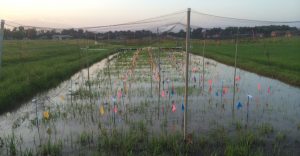 It’s great to see all the hard work from the research team at Pine Bluff, AR finally pay off! In this beautiful sunset picture you can see the seedlings emerging from the flooded field. With pre-germinated rice seeds it does not take long for rice to emerge from the water. This picture was taken on June 16th, 2016, only 8 days after the the seeds were prepared for the water seed replicated yield trial. We’ll check back in on the Pine Bluff, AR site as the rice continues to grow!
It’s great to see all the hard work from the research team at Pine Bluff, AR finally pay off! In this beautiful sunset picture you can see the seedlings emerging from the flooded field. With pre-germinated rice seeds it does not take long for rice to emerge from the water. This picture was taken on June 16th, 2016, only 8 days after the the seeds were prepared for the water seed replicated yield trial. We’ll check back in on the Pine Bluff, AR site as the rice continues to grow!
07/22/2016
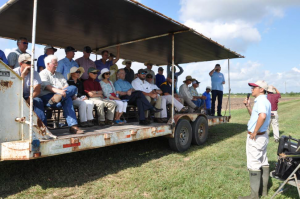 We recently held our stakeholder advisory board meeting and organic rice workshop at the 69th Annual Beaumont Field Day in Beaumont, TX. The day was a great success, with over 40 attendees. The day started with introductory remarks by Dr. Shane Zhou, who spoke of the need to provide management practices for organic rice production. The introduction was followed by research presentations on Insect Management by Mo Way, Seeding Rate Effect on Growth and Yield by Fugen Dou, Disease Management by Shane Zhou, Organic Rice in South Carolina by Brian Ward, and Cost-Benefit Economic Analysis by Brad Watkins. After the Organic Rice Workshop presentations we held our Stakeholder Advisory Board Meeting, including a project overview by Shane Zhou and Jessica Shade, a Research Update in Arkansas by Bihu Huang, Anna McClung and Sixte Ntamatungiro, and a presentation about Weed Management Research by Muthu Bagavathiannan.
We recently held our stakeholder advisory board meeting and organic rice workshop at the 69th Annual Beaumont Field Day in Beaumont, TX. The day was a great success, with over 40 attendees. The day started with introductory remarks by Dr. Shane Zhou, who spoke of the need to provide management practices for organic rice production. The introduction was followed by research presentations on Insect Management by Mo Way, Seeding Rate Effect on Growth and Yield by Fugen Dou, Disease Management by Shane Zhou, Organic Rice in South Carolina by Brian Ward, and Cost-Benefit Economic Analysis by Brad Watkins. After the Organic Rice Workshop presentations we held our Stakeholder Advisory Board Meeting, including a project overview by Shane Zhou and Jessica Shade, a Research Update in Arkansas by Bihu Huang, Anna McClung and Sixte Ntamatungiro, and a presentation about Weed Management Research by Muthu Bagavathiannan.
07/19/2016
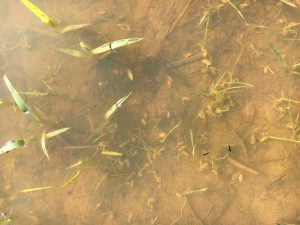 The seeds you see being planted into the field in our last post from Pine Bluff, AR are starting to sprout! Here is a picture that was taken on June 13th, 2016 that shows the sprouted rice seeds taking root in the flooded field. Rice fields are only flooded to a shallow depth of around 5 inches. The reason that the fields are flooded is that most rice varieties grow better and produce higher yields in flooded soils, but in organic management flooding is also used as an important tool for weed suppression. Controlling weeds without the use of herbicide is a challenge for all organic farmers, and organic rice farmers struggle with weeds such as grasses and nutsedge. Luckily, because rice can out-compete these weeds in flooded fields, flooding can be an effective tool for organic farmers to fight weeds without pesticides! Next we’ll show you the rice seedlings as they emerge from the flooded fields in our organic plots.
The seeds you see being planted into the field in our last post from Pine Bluff, AR are starting to sprout! Here is a picture that was taken on June 13th, 2016 that shows the sprouted rice seeds taking root in the flooded field. Rice fields are only flooded to a shallow depth of around 5 inches. The reason that the fields are flooded is that most rice varieties grow better and produce higher yields in flooded soils, but in organic management flooding is also used as an important tool for weed suppression. Controlling weeds without the use of herbicide is a challenge for all organic farmers, and organic rice farmers struggle with weeds such as grasses and nutsedge. Luckily, because rice can out-compete these weeds in flooded fields, flooding can be an effective tool for organic farmers to fight weeds without pesticides! Next we’ll show you the rice seedlings as they emerge from the flooded fields in our organic plots.
07/12/2016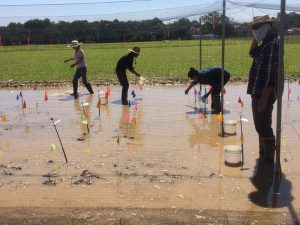 The Pine Bluff, AR organic rice field sites are finally getting seeded with rice. Before planting, the fields get flooded with a shallow layer of water. We’ll talk more about why fields get flooded in our next post (and we’ll include a close-up of the seeds sprouting in the flooded fields), but in this picture you can see that the flooded fields are getting seeded by researchers with pipped (pregerminated) rice seeds. You can also see the experimental plots that the researchers have set up in this field site, because each plot perimeter is marked by yellow, orange, and pink flags. It was a hot, sunny day to be out in the field, so the researchers are all wearing hats to keep the sun off their faces. They are also wearing tall boots to prevent their feet from getting wet in the flooded fields. Rice planting by hand is an exhausting, back breaking process! Next we’ll take a closer look at the seeds in the field to see how they are sprouting, so stay tuned.
The Pine Bluff, AR organic rice field sites are finally getting seeded with rice. Before planting, the fields get flooded with a shallow layer of water. We’ll talk more about why fields get flooded in our next post (and we’ll include a close-up of the seeds sprouting in the flooded fields), but in this picture you can see that the flooded fields are getting seeded by researchers with pipped (pregerminated) rice seeds. You can also see the experimental plots that the researchers have set up in this field site, because each plot perimeter is marked by yellow, orange, and pink flags. It was a hot, sunny day to be out in the field, so the researchers are all wearing hats to keep the sun off their faces. They are also wearing tall boots to prevent their feet from getting wet in the flooded fields. Rice planting by hand is an exhausting, back breaking process! Next we’ll take a closer look at the seeds in the field to see how they are sprouting, so stay tuned.
07/09/2016
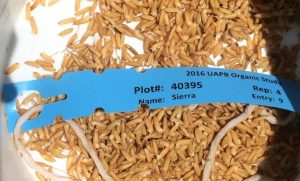 Here is a close-up picture of the seeds that are being used at the Pine Bluff, AR organic rice field sites. In this picture, we capture a bucket containing pregerminated (also called pipped) seeds that have been soaked in water and then allowed to drain. This is a Sierra variety of rice that will be included in the water seeding trials that we are working on. Notice the tag that lists all the important information, including the plot number, the name of the rice, and the name of this study. Once the rice has been pipped it will get planted into the field. We’ll post a picture of our team members planting the pipped rice into the field in our next post!
Here is a close-up picture of the seeds that are being used at the Pine Bluff, AR organic rice field sites. In this picture, we capture a bucket containing pregerminated (also called pipped) seeds that have been soaked in water and then allowed to drain. This is a Sierra variety of rice that will be included in the water seeding trials that we are working on. Notice the tag that lists all the important information, including the plot number, the name of the rice, and the name of this study. Once the rice has been pipped it will get planted into the field. We’ll post a picture of our team members planting the pipped rice into the field in our next post!
07/02/2016
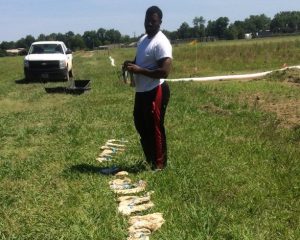 This picture was taken on June 8, 2016 at our organic rice field sites at Pine Bluff, AR when the researchers were preparing to water the seed replicated yield trial. In it, you can see several cloth bags lined up in the grass by the feet of one of the researchers standing next to the organic experimental plots. Each bag contains the seed for each plot, which the team weighed out carefully to make sure that each plot will get an equal number of seeds. After weighing, the bags of seeds were soaked in water and then drained to allow the seeds to pre-germinate. This pre-germination stage of rice seedling development is called pipping, and helps to ensure that the seeds will sprout before sowing them in the ground. Many varieties of rice have a dormancy period that results in low germination. Pipping seeds by submerging them in water for 12-24 hours (or until small shoots appear) can help overcome this dormancy, but the seeds must be planted before the roots exceed 5mm in length. In our next post we’ll show you a close up of the rice seeds that are being pregerminated.
This picture was taken on June 8, 2016 at our organic rice field sites at Pine Bluff, AR when the researchers were preparing to water the seed replicated yield trial. In it, you can see several cloth bags lined up in the grass by the feet of one of the researchers standing next to the organic experimental plots. Each bag contains the seed for each plot, which the team weighed out carefully to make sure that each plot will get an equal number of seeds. After weighing, the bags of seeds were soaked in water and then drained to allow the seeds to pre-germinate. This pre-germination stage of rice seedling development is called pipping, and helps to ensure that the seeds will sprout before sowing them in the ground. Many varieties of rice have a dormancy period that results in low germination. Pipping seeds by submerging them in water for 12-24 hours (or until small shoots appear) can help overcome this dormancy, but the seeds must be planted before the roots exceed 5mm in length. In our next post we’ll show you a close up of the rice seeds that are being pregerminated.
06/30/2016
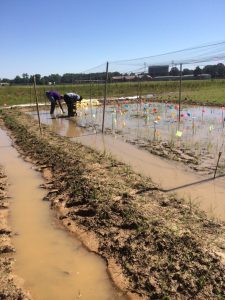 More updates from our organic rice field sites at Pine Bluff, AR! We are finally getting ready to plant our rice crop. However, before we get the organic rice in the ground we need to prep the field. In this picture Dr. Anna McClung and her research team from the USDA-ARS Dale Bumpers National Rice Research Center are hand weeding the experimental plots prior to seeding them with rice. As you can see from the picture, there was a heavy infestation of grasses and nutsedge. Sedges and grasses are a major pest for rice growers, and organic growers have had to find novel ways to control them. These weeds have also proven difficult to control for conventional farmers, because we are increasingly seeing herbicide-resistant weeds that cannot be controlled with pesticides. For example, in 2010 populations of rice flatsedge were found to be resistant to acetolactate synthase (ALS) inhibiting herbicides, a group of herbicides commonly used in conventional rice farming that includes the brand-names Newpath, Regiment and Permit. That resistance has continued to spread, and can now be found not only in annual sedges, but in perennial, tuber-propagated sedges as well. Because the use of synthetic herbicides like ALS inhibitors is banned in organic farming, organic farmers have had to examine ways to control these weeds using non-chemical methods, and these methods could be of use to conventional farmers. Our research examines cover crop production systems which, in combination with cultivar choice and seed treatment, can help control these weeds (in addition to controlling diseases, insect pests, and helping with nutrient management). Our hope is that this research will not only prove useful for organic farmers, but could also be adopted into conventional protocols, allowing a sustainable solution to herbicide-resistant weeds.
More updates from our organic rice field sites at Pine Bluff, AR! We are finally getting ready to plant our rice crop. However, before we get the organic rice in the ground we need to prep the field. In this picture Dr. Anna McClung and her research team from the USDA-ARS Dale Bumpers National Rice Research Center are hand weeding the experimental plots prior to seeding them with rice. As you can see from the picture, there was a heavy infestation of grasses and nutsedge. Sedges and grasses are a major pest for rice growers, and organic growers have had to find novel ways to control them. These weeds have also proven difficult to control for conventional farmers, because we are increasingly seeing herbicide-resistant weeds that cannot be controlled with pesticides. For example, in 2010 populations of rice flatsedge were found to be resistant to acetolactate synthase (ALS) inhibiting herbicides, a group of herbicides commonly used in conventional rice farming that includes the brand-names Newpath, Regiment and Permit. That resistance has continued to spread, and can now be found not only in annual sedges, but in perennial, tuber-propagated sedges as well. Because the use of synthetic herbicides like ALS inhibitors is banned in organic farming, organic farmers have had to examine ways to control these weeds using non-chemical methods, and these methods could be of use to conventional farmers. Our research examines cover crop production systems which, in combination with cultivar choice and seed treatment, can help control these weeds (in addition to controlling diseases, insect pests, and helping with nutrient management). Our hope is that this research will not only prove useful for organic farmers, but could also be adopted into conventional protocols, allowing a sustainable solution to herbicide-resistant weeds.
06/26/2016
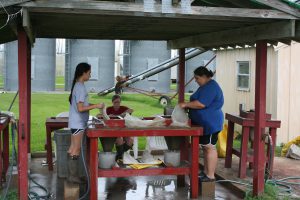 Here is a picture from our collaborator Dr. M.O. (Mo) Way, Professor of Entomology at Texas AgriLife Research and Extension Center. It shows his research team processing rice water weevil samples. Dr. Way’s team is evaluating a potential rice water weevil organic bio-insecticde that can be used by organic growers to control the pests. Water weevils are one of the most common – and most problematic – pests for organic rice. Both the adults and larva can damage a rice crop. The adults feed on the tops of rice leaves, eating away narrow scars that parallel the leaf midrib. When the number of adult weevils are high enough, they can even kill young rice plants. The larva is even more damaging for rice, because they feed on the rice roots, which can reduce the nutrient uptake by rice plants. Larval feeding on rice can decrease rice yields, and make rice stands thin and short.
Here is a picture from our collaborator Dr. M.O. (Mo) Way, Professor of Entomology at Texas AgriLife Research and Extension Center. It shows his research team processing rice water weevil samples. Dr. Way’s team is evaluating a potential rice water weevil organic bio-insecticde that can be used by organic growers to control the pests. Water weevils are one of the most common – and most problematic – pests for organic rice. Both the adults and larva can damage a rice crop. The adults feed on the tops of rice leaves, eating away narrow scars that parallel the leaf midrib. When the number of adult weevils are high enough, they can even kill young rice plants. The larva is even more damaging for rice, because they feed on the rice roots, which can reduce the nutrient uptake by rice plants. Larval feeding on rice can decrease rice yields, and make rice stands thin and short.
06/20/2016
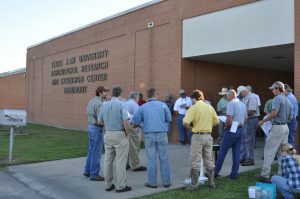 We’re preparing for the Organic Rice Workshop prepared by the Center of Excellence for Organic Rice Research in the US for our USDA/NIFA OREI Organic Rice Research Project. The workshop will be held on Thursday, July 14, 2016 at the Texas A&M AgriLife Research and Extension Center, Beaumont, TX as part of the the 69th Annual Beaumont Field Day. The objectives of this workshop are to provide research results and management tips for organic rice production and management involved in variety selection, nutrient management, cover crop use, weed, disease and insect pest management, cost-benefit economic analysis, etc. Following the workshop, we will host the 2nd project stakeholder advisory board meeting to discuss about the progress of this project, and to seek for advice from the advisory board members to improve the project.
We’re preparing for the Organic Rice Workshop prepared by the Center of Excellence for Organic Rice Research in the US for our USDA/NIFA OREI Organic Rice Research Project. The workshop will be held on Thursday, July 14, 2016 at the Texas A&M AgriLife Research and Extension Center, Beaumont, TX as part of the the 69th Annual Beaumont Field Day. The objectives of this workshop are to provide research results and management tips for organic rice production and management involved in variety selection, nutrient management, cover crop use, weed, disease and insect pest management, cost-benefit economic analysis, etc. Following the workshop, we will host the 2nd project stakeholder advisory board meeting to discuss about the progress of this project, and to seek for advice from the advisory board members to improve the project.
The theme for this year’s rice field day is “Innovation: Key to Better Rice Production” with three keynote speakers: Dr. Eric Webster, weed scientist at the LSU AgriCenter will give a talk on Provisia Rice; Dr. Chenghai Yang, agricultural engineer at the USDA ARS Aerial Application Technology Research Unit will provide a talk on remote sensing and aerial application technology for rice production; and Dr. Jason Krutz, extension/research irrigation specialist at Mississippi State University will give a talk on alternate wetting and drying irrigation technology for rice production. We encourage the public to sign up! Details can be found here.
05/12/2016
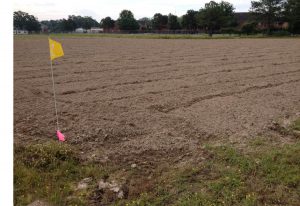 We have finally reached the end of the first cover crop cycle at the Pine Bluff, AR organic rice field sites. After the cover crops were sampled for biomass measurements and species composition the remaining cover crops were mowed and incorporated into the soil. This is a picture of what the field looked like on May 2, 2016 after the cover crops were incorporated into the field. The next phase for Pine Bluff is the rice phase, so stay tuned for pictures of the field preparation and rice planting ahead!
We have finally reached the end of the first cover crop cycle at the Pine Bluff, AR organic rice field sites. After the cover crops were sampled for biomass measurements and species composition the remaining cover crops were mowed and incorporated into the soil. This is a picture of what the field looked like on May 2, 2016 after the cover crops were incorporated into the field. The next phase for Pine Bluff is the rice phase, so stay tuned for pictures of the field preparation and rice planting ahead!
05/01/2016
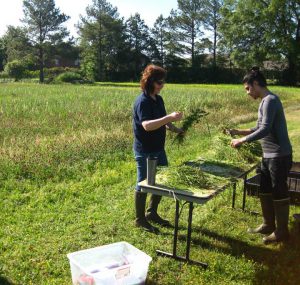 It’s finally time to do some harvesting at our organic rice field sites at Pine Bluff, AR. We aren’t talking about rice harvest, however. The research team at Pine Bluff harvested the cover crops and weeds in the flagged plot areas of the field site to examine the amount and species composition of the biomass growing on the field. The team had to separate out the plant species to see what was growing on the field. In this picture you can see the research team going through the harvest to categorize the different species of cover crops and weeds. Thanks again to Dr. Anna McClung and her research team from the USDA-ARS Dale Bumpers National Rice Research Center for these great pictures. It’s wonderful to see the research team in action out in the field! Stay tuned for the next photo, which will look at the field after the cover crops are mowed and incorporated into the soil!
It’s finally time to do some harvesting at our organic rice field sites at Pine Bluff, AR. We aren’t talking about rice harvest, however. The research team at Pine Bluff harvested the cover crops and weeds in the flagged plot areas of the field site to examine the amount and species composition of the biomass growing on the field. The team had to separate out the plant species to see what was growing on the field. In this picture you can see the research team going through the harvest to categorize the different species of cover crops and weeds. Thanks again to Dr. Anna McClung and her research team from the USDA-ARS Dale Bumpers National Rice Research Center for these great pictures. It’s wonderful to see the research team in action out in the field! Stay tuned for the next photo, which will look at the field after the cover crops are mowed and incorporated into the soil!
04/21/2016
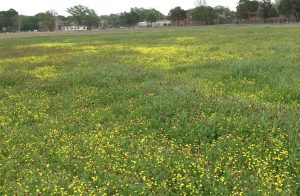 Time for another check in at our organic rice field sites at Pine Bluff, AR. Thanks to Dr. Anna McClung and her research team from the USDA-ARS Dale Bumpers National Rice Research Center for more photos from their experimental plots! This one was taken on April 13, 2016. You can see that the crimson clover cover crop is growing best in the higher, drier areas. The wetter, lower areas have more buttercup weeds.
Time for another check in at our organic rice field sites at Pine Bluff, AR. Thanks to Dr. Anna McClung and her research team from the USDA-ARS Dale Bumpers National Rice Research Center for more photos from their experimental plots! This one was taken on April 13, 2016. You can see that the crimson clover cover crop is growing best in the higher, drier areas. The wetter, lower areas have more buttercup weeds.
04/01/2016
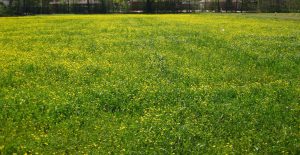 Here is another picture from our organic rice field sites at Pine Bluff, AR, where Dr. Anna McClung and her research team from the USDA-ARS Dale Bumpers National Rice Research Center have been documenting their experimental plots. This one clearly shows that the beautiful buttercup weed is taking off. Most buttercup species like wet, moist areas, so boggy rice fields are ideal habitat for them.
Here is another picture from our organic rice field sites at Pine Bluff, AR, where Dr. Anna McClung and her research team from the USDA-ARS Dale Bumpers National Rice Research Center have been documenting their experimental plots. This one clearly shows that the beautiful buttercup weed is taking off. Most buttercup species like wet, moist areas, so boggy rice fields are ideal habitat for them.
03/20/2016
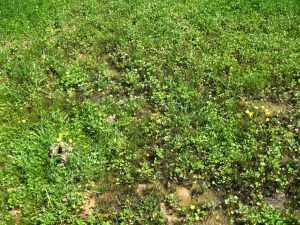 Now we’ll take a look at how the organic research site at Pine Bluff, AR has been going. These pictures are from Dr. Anna McClung and her research team at the USDA-ARS Dale Bumpers National Rice Research Center. The plants at the site have been getting established, but there are still some water logged areas. This picture was taken on March 16, 2016, and you can see some still water in the muddy fields. The cover crops are doing well though, and are greening up the field!
Now we’ll take a look at how the organic research site at Pine Bluff, AR has been going. These pictures are from Dr. Anna McClung and her research team at the USDA-ARS Dale Bumpers National Rice Research Center. The plants at the site have been getting established, but there are still some water logged areas. This picture was taken on March 16, 2016, and you can see some still water in the muddy fields. The cover crops are doing well though, and are greening up the field!
02/24/2016
 We’re gearing up for our first USDA/NIFA OREI Organic Rice Research Project stakeholder advisory board meeting. The purpose of the meeting is to update stakeholders on the progress of the project, outline the research and extension activities for 2016, and get inputs from the stakeholder advisory board members to improve the project. The meeting will be held in Galveston, TX as part of the 2016 Rice Technical Working Group Meeting. The Rice Technical Working Group (RTWG) is comprised of people who are actively engaged in rice research, from State Agricultural Experiment Stations and the Agricultural Extension Services of Arkansas, California, Florida, Louisiana, Mississippi, Missouri, and Texas, and the Agricultural Research Service (ARS), the Economic Research Service (ERS), the Cooperative State Research, Education, and Extension Service (CSREES), and other agencies of the United States Department of Agriculture as well as other cooperating public agencies and participating industry groups. Since 1960, research scientists and administrators from the U.S.rice industry and from international agencies have participated in the biennial meetings. This year’s meeting will cover topics including water sustainability, value-addition, increasing rice acreage, climate yield, and more. For more information about the RTWG meeting, visit the agenda page here.
We’re gearing up for our first USDA/NIFA OREI Organic Rice Research Project stakeholder advisory board meeting. The purpose of the meeting is to update stakeholders on the progress of the project, outline the research and extension activities for 2016, and get inputs from the stakeholder advisory board members to improve the project. The meeting will be held in Galveston, TX as part of the 2016 Rice Technical Working Group Meeting. The Rice Technical Working Group (RTWG) is comprised of people who are actively engaged in rice research, from State Agricultural Experiment Stations and the Agricultural Extension Services of Arkansas, California, Florida, Louisiana, Mississippi, Missouri, and Texas, and the Agricultural Research Service (ARS), the Economic Research Service (ERS), the Cooperative State Research, Education, and Extension Service (CSREES), and other agencies of the United States Department of Agriculture as well as other cooperating public agencies and participating industry groups. Since 1960, research scientists and administrators from the U.S.rice industry and from international agencies have participated in the biennial meetings. This year’s meeting will cover topics including water sustainability, value-addition, increasing rice acreage, climate yield, and more. For more information about the RTWG meeting, visit the agenda page here.
Here is a closeup picture showing the seedlings coming up at the Pine Bluff, AR site. You can see that the majority of emerging seedlings are the cover crops that we so painstakingly planted, so the fertilizer application, ground smoothing, seed drilling and broadcasting, and soil packing were well worth the effort. We’ll be keeping an eye on our cover crops as they grow throughout the winter season, so stay tuned for more updates.
02/01/2016
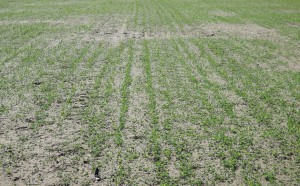 Now that we’ve taken an in-depth look at the plots in Beaumont sites let’s see how the plots are doing back at the Pine Bluff, AR site. We were lucky to get everything planted shortly before some timely rains, so were able to take advantage of the moisture. Our stands of winter wheat and clover look very good, but we also see some weedy grasses starting to emerge. Now the race is on between our cover crops and the weeds. Luckily we chose fast-growing cover crops that will have a thick carpet of vegetation, so hopefully we’ll see the cover crops out-compete the weeds soon!
Now that we’ve taken an in-depth look at the plots in Beaumont sites let’s see how the plots are doing back at the Pine Bluff, AR site. We were lucky to get everything planted shortly before some timely rains, so were able to take advantage of the moisture. Our stands of winter wheat and clover look very good, but we also see some weedy grasses starting to emerge. Now the race is on between our cover crops and the weeds. Luckily we chose fast-growing cover crops that will have a thick carpet of vegetation, so hopefully we’ll see the cover crops out-compete the weeds soon!
01/26/2016
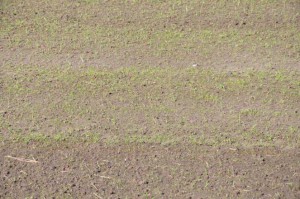 Here is a closeup picture of the fallow plot in Beaumont, TX. You can see that the seedlings sprouting are more diverse than the seedlings coming up in our Ryegrass or Brassica cover crop plots. We are comparing our treatment cover crop plots to the fallow field to see if cover crops have advantages over fallow fields or not. Some of the potential cover crop benefits include improved infiltration of surface water, adding organic matter that encourages the growth of beneficial soil microbial life, enhancing nutrient cycling, reducing weed pressures, encouraging beneficial insects and nematodes, and preventing soil erosion, conserving soil moisture.
Here is a closeup picture of the fallow plot in Beaumont, TX. You can see that the seedlings sprouting are more diverse than the seedlings coming up in our Ryegrass or Brassica cover crop plots. We are comparing our treatment cover crop plots to the fallow field to see if cover crops have advantages over fallow fields or not. Some of the potential cover crop benefits include improved infiltration of surface water, adding organic matter that encourages the growth of beneficial soil microbial life, enhancing nutrient cycling, reducing weed pressures, encouraging beneficial insects and nematodes, and preventing soil erosion, conserving soil moisture.
01/25/2016
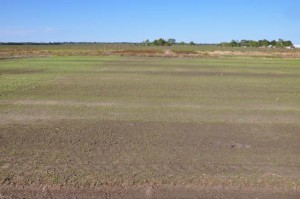 Now that we’ve had a chance to get the overall and close-up looks at our Ryegrass and Brassica cover crop plots in Beaumont, TX it’s time to talk about our Winter Fallow Control Plot. We’ll be comparing our treatment plots with Ryegrass and Brassica to this fallow control plot, which had no cover crops planted on it. The soil was treated in the same way as our other treatment plots, but instead of seeding on October 20th, 2015, this plot was left unseeded. Similar to the other pictures posted from the Beaumont field site, these picture were taken on November 9th, 2015, but have a very different species compositions than the treatment crops.
Now that we’ve had a chance to get the overall and close-up looks at our Ryegrass and Brassica cover crop plots in Beaumont, TX it’s time to talk about our Winter Fallow Control Plot. We’ll be comparing our treatment plots with Ryegrass and Brassica to this fallow control plot, which had no cover crops planted on it. The soil was treated in the same way as our other treatment plots, but instead of seeding on October 20th, 2015, this plot was left unseeded. Similar to the other pictures posted from the Beaumont field site, these picture were taken on November 9th, 2015, but have a very different species compositions than the treatment crops.
01/07/2016
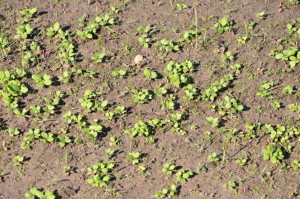 This is a close up picture of the Brassica Cover Crop at our field site in Beaumont, TX. Notice that the seedlings look different than the Ryegrass seedlings because of the wide, two-leaf cotyledons. Brassica cover crops are used because they can grow rapidly in the fall, creating a large amount of biomass quickly with over 80% soil coverage and up to 8,000 pounds of biomass per acre. They also have excellent nutrient capturing abilities. Finally, most species of the Brassica genus have the added benefit of pest management. These plants can release biotoxic compounds into the soil, with the potential to control plant pests and pathogens, such as fungi, nematodes, and even some weeds.
This is a close up picture of the Brassica Cover Crop at our field site in Beaumont, TX. Notice that the seedlings look different than the Ryegrass seedlings because of the wide, two-leaf cotyledons. Brassica cover crops are used because they can grow rapidly in the fall, creating a large amount of biomass quickly with over 80% soil coverage and up to 8,000 pounds of biomass per acre. They also have excellent nutrient capturing abilities. Finally, most species of the Brassica genus have the added benefit of pest management. These plants can release biotoxic compounds into the soil, with the potential to control plant pests and pathogens, such as fungi, nematodes, and even some weeds.
01/06/2016
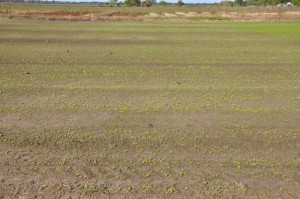 We hope everyone had a great holiday season! We’re excited to be back to share more with you about what’s been going on with our field sites. Our last update looked at the Ryegrass Cover Crop at our field site in Beaumont, TX. For this entry we’ll stay at our Beaumont site, but take a look at a different cover crop: our Brassica Cover Crop. The Brassica in this picture was planted at a rate of 20 pounds per acre on October 20th, 2015, and the picture shown in this post was taken on November 9th, 2015. As with our Ryegrass entry, next we’ll be showing a close-up of what the sprouts look like on the field!
We hope everyone had a great holiday season! We’re excited to be back to share more with you about what’s been going on with our field sites. Our last update looked at the Ryegrass Cover Crop at our field site in Beaumont, TX. For this entry we’ll stay at our Beaumont site, but take a look at a different cover crop: our Brassica Cover Crop. The Brassica in this picture was planted at a rate of 20 pounds per acre on October 20th, 2015, and the picture shown in this post was taken on November 9th, 2015. As with our Ryegrass entry, next we’ll be showing a close-up of what the sprouts look like on the field!
12/20/2015
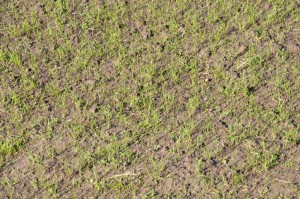 This picture is a close up of the Ryegrass Cover Crop at our field site in Beaumont, TX. You can see the small seedlings starting to grow through the soil. Notice that the seedlings look like small grass shoots. This is because rye is a type of grass. There are many benefits to using rye as a cover crop: its roots create pores in the ground that prevent the soil from turning into a hardpan during drought years, it provides quick ground cover which controls erosion, it can help keep nitrogen in the soil profile and available for the crop the following year, it produces biomass that can increase soil organic matter and fertility, it has vigorous seedlings that quickly form a cover to compete with winter annual weeds, and it has an extensive and deep root system that provides pathways for increased water infiltration.
This picture is a close up of the Ryegrass Cover Crop at our field site in Beaumont, TX. You can see the small seedlings starting to grow through the soil. Notice that the seedlings look like small grass shoots. This is because rye is a type of grass. There are many benefits to using rye as a cover crop: its roots create pores in the ground that prevent the soil from turning into a hardpan during drought years, it provides quick ground cover which controls erosion, it can help keep nitrogen in the soil profile and available for the crop the following year, it produces biomass that can increase soil organic matter and fertility, it has vigorous seedlings that quickly form a cover to compete with winter annual weeds, and it has an extensive and deep root system that provides pathways for increased water infiltration.
Now we’ll take a look at how some of the specific cover crop fields are doing 20 days after planting at our field sites in Beaumont, TX. We’ll start with a glimpse at the over-all view of our Ryegrass Cover Crop field. This annual ryegrass cover crop was planted at the rate of 50 pounds per acre on October 20th, 2015, and the picture shown in this post was taken on November 9th, 2015. Next we’ll be showing a close-up of what the sprouts look like on the field!
Here is our “after” picture for the Organic Land Strip site at our field site in Beaumont, TX. This picture was taken 20 days after planting, and you can start seeing the green sprouts coming up through the soil. Stay tuned for pictures of specific cover crops, as we’ll be posting overviews and close-ups of the Beaumont ryegrass, brassica, and fallow plots next.
12/10/2015
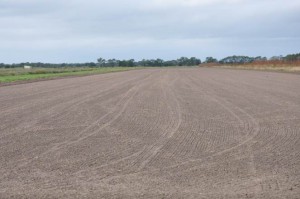 If you’re eager to hear about some of our other research field sites, then you are in luck! Get ready for a series of before and after updates from our field sites in Beaumont, TX from the research team led by Dr. Shane Zhou. This first pictures gives you a sense for what the Organic Land Stripe site looked like before we started planting on it. Notice the prepared field with nothing growing on it. Next we’ll be posting a picture of what the field looks like 20 days after planting, so start guessing how much green (or lack there of) you’ll see on the same field!
If you’re eager to hear about some of our other research field sites, then you are in luck! Get ready for a series of before and after updates from our field sites in Beaumont, TX from the research team led by Dr. Shane Zhou. This first pictures gives you a sense for what the Organic Land Stripe site looked like before we started planting on it. Notice the prepared field with nothing growing on it. Next we’ll be posting a picture of what the field looks like 20 days after planting, so start guessing how much green (or lack there of) you’ll see on the same field!
After all the hard work of amending the soil, smoothing, drilling the seeds, packing the ground, and planting the cover crops we’re finally starting to see some growth at our field sites in Pine Bluff, AR! This is a picture of the cover crops that we planted emerging from the ground. Although for now it looks a little more bare than the fallow site, with the upcoming winter rains we expect to see a full crop growing strong soon. Stay tuned as the cover crops emerge, as we’ll be posting more pictures of our Pine Bluff, AR field site!
11/30/2015
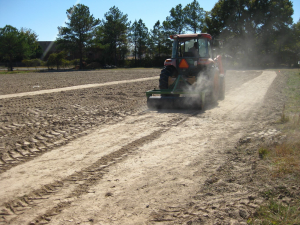 Now that we finished spreading the cover crop seeds at our filed sites in Pine Bluff, AR it’s time to pack the ground. Packing the ground after seeding is important, because seeds and seedlings need solid contact with the soil for germination and emergence. This early stage in a plant’s life is extremely vulnerable, and having a specific set of optimal growing conditions is key to the plant’s survival. For example, plants need to absorb water before they can germinate, and after they germinate seed-to-soil contact helps roots access soil moisture and prevent seedling desiccation. Proper soil preparation, including packing the soil, can help plants in these early life stages. Well-packed soil not only improves consistent seed and root contact, but also helps retain moisture, since airflow between soil particles is reduced. If soil is properly firmed, an adult footprint will be about ¼ inch deep.
Now that we finished spreading the cover crop seeds at our filed sites in Pine Bluff, AR it’s time to pack the ground. Packing the ground after seeding is important, because seeds and seedlings need solid contact with the soil for germination and emergence. This early stage in a plant’s life is extremely vulnerable, and having a specific set of optimal growing conditions is key to the plant’s survival. For example, plants need to absorb water before they can germinate, and after they germinate seed-to-soil contact helps roots access soil moisture and prevent seedling desiccation. Proper soil preparation, including packing the soil, can help plants in these early life stages. Well-packed soil not only improves consistent seed and root contact, but also helps retain moisture, since airflow between soil particles is reduced. If soil is properly firmed, an adult footprint will be about ¼ inch deep.
11/17/2015
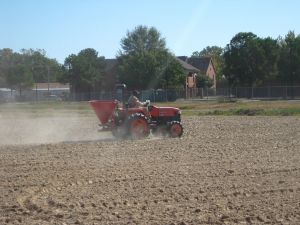 We have been busy at our Pine Bluff, AR field site. In this picture we’re broadcasting crimson clover as a cover crop. Using crimson clover as a cover crop has many benefits. It has rapid, robust growth and is a leguminous plant, so can fix nitrogen using root bacteria called Rhizobia. It’s especially useful because it grows quickly in the fall (or in the summer in colder regions), which makes it ideal for short-rotation niches as a weed suppressing green manure crop. It is wide spread, and you can see it blooming everywhere from California nut groves to between rows of blueberries in Michigan. When seeded as a winter annual, as we are doing in our Pine Bluff field site, crimson clover produces around 3,500 to 5,500 pounds of dry material, and fixes around 70 to 150 pounds of nitrogen by mid-May. An additional benefit of seeding crimson clover is that it provides habitat and acts as a nectar source for beneficial insects.
We have been busy at our Pine Bluff, AR field site. In this picture we’re broadcasting crimson clover as a cover crop. Using crimson clover as a cover crop has many benefits. It has rapid, robust growth and is a leguminous plant, so can fix nitrogen using root bacteria called Rhizobia. It’s especially useful because it grows quickly in the fall (or in the summer in colder regions), which makes it ideal for short-rotation niches as a weed suppressing green manure crop. It is wide spread, and you can see it blooming everywhere from California nut groves to between rows of blueberries in Michigan. When seeded as a winter annual, as we are doing in our Pine Bluff field site, crimson clover produces around 3,500 to 5,500 pounds of dry material, and fixes around 70 to 150 pounds of nitrogen by mid-May. An additional benefit of seeding crimson clover is that it provides habitat and acts as a nectar source for beneficial insects.
We have drill seeded winter wheat into our field site at Pine Bluff, AR. Drill seeding is a process that is used for precise planting using a tractor with a specialized seed drill attachment. The drill opens a furrow in the ground, places the seed at a specific depth in the soil, and then covers the seed with a packing mechanism. There are many benefits to drill seeding – it allows the seeds to be equally spaced, to be placed at a proper depth in the ground, and reduces seed predation, especially from birds, because the the seeds are covered with soil.
11/13/2015
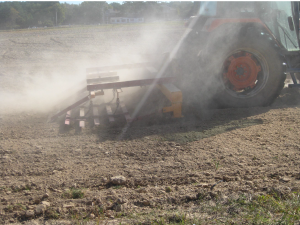 This picture shows us smoothing the ground at our Pine Bluff, AR site in preparation for planting. We want to make sure all the areas of our field site are smooth and level before spreading our seeds, because this helps firm up the soil, break up any clods, and leaves an even surface for seeding. It’s important to not leave the soil in rough conditions for too long, because it runs the risk of drying out and forming hard clods, which makes it much more difficult to prepare a good seedbed for our cover crops. I know everyone is ready to see some rice get planted, but first we’ll be planting cover crops, so stay tuned for pictures of us planting clover and wheat.
This picture shows us smoothing the ground at our Pine Bluff, AR site in preparation for planting. We want to make sure all the areas of our field site are smooth and level before spreading our seeds, because this helps firm up the soil, break up any clods, and leaves an even surface for seeding. It’s important to not leave the soil in rough conditions for too long, because it runs the risk of drying out and forming hard clods, which makes it much more difficult to prepare a good seedbed for our cover crops. I know everyone is ready to see some rice get planted, but first we’ll be planting cover crops, so stay tuned for pictures of us planting clover and wheat.
11/11/2015
As we continue to establish the Pine Bluff, AR site, the next step in getting the field ready is incorporating the fertilizer we spread on the field into the soil. This pictures shows the incorporation process of our organic fertilizer. 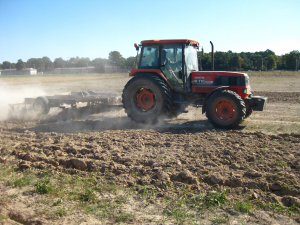 One of the benefits of using organic methods for increasing soil fertility is that it not only puts nutrients into the ground, but it also builds a more healthy soil environment. Several studies have shown benefits of organic soil management including, one study published in Crop Management summarizing results from the Iowa State Long-Term Agroecological Research Experiment concluding that organic management resulted in healthier soil, as “organic plots had up to 40 percent more biologically-active soil organic matter, which is important for fertility and nutrient availability.” Organic soils had other health-related qualities, such as lower acidity and higher amounts of carbon, nitrogen, potassium, phosphorous and calcium than conventional soils. This study is not alone in its findings regarding the soil benefits of organic management. For example, a study published in the journal Ecological Indicators found that “organic management showed significantly better soil nutritional and microbiological conditions; with increased level of total nitrogen, nitrate and available phosphorus, and an increased microbial biomass content, and enzymatic activities.”
One of the benefits of using organic methods for increasing soil fertility is that it not only puts nutrients into the ground, but it also builds a more healthy soil environment. Several studies have shown benefits of organic soil management including, one study published in Crop Management summarizing results from the Iowa State Long-Term Agroecological Research Experiment concluding that organic management resulted in healthier soil, as “organic plots had up to 40 percent more biologically-active soil organic matter, which is important for fertility and nutrient availability.” Organic soils had other health-related qualities, such as lower acidity and higher amounts of carbon, nitrogen, potassium, phosphorous and calcium than conventional soils. This study is not alone in its findings regarding the soil benefits of organic management. For example, a study published in the journal Ecological Indicators found that “organic management showed significantly better soil nutritional and microbiological conditions; with increased level of total nitrogen, nitrate and available phosphorus, and an increased microbial biomass content, and enzymatic activities.”
11/10/2015
Our field sites in Pine Bluff, AR are being established! This is a picture or organic fertilizer being applied to the field. Organic production prohibits the use of synthetic fertilizer, so organic farms use natural soil amendments, such as compost and animal manure, to keep their soil healthy. This is especially important for soils that might be depleted of nutrients, and our tests show that we are in serious need of some nutrient additions (see our 11/9/2015 update). Because our data showed that our soils were low in phosphorus, potassium, and zinc, we’re using organic fertilizer to help us create a more nutritious environment for the cover crop and rice seeds that we will be planting.
We tested the soil of our fallow field at Pine Bluff, AR this fall to look at different nutrients, including phosphorus, potassium, calcium, magnesium, sulfur, zinc, iron, magnesium, copper, boron, and available nitrogen. We found that even though the land we’re planting on has been fallow for several years it is still very nutrient depleted. This was especially true for phosphorus, potassium, and zinc, which we’ve highlighted in the table. The level of phosphorus was low, and the levels of potassium and zinc were very low. To address this we’ll need to add organic soil amendments that can increase the soil nutrients. Stay tuned for tomorrow, when we’ll post a picture of organic fertilizer being applied to the field.
Here is another photo from our field site in Pine Bluff, AR. This is actually the same field site as the one pictured in our 11/4/2015 update, but you can see that in this picture the field site has been leveled in preparation for planting. This is getting closer to what the field site will look like during trials, but it still needs to be planted. You can see that we posted a sign marking the site as organic: we don’t want anyone confusing this with a conventional site!
We just got in new pictures from our field site in Pine Bluff, AR! This one shows what the site looked like before cultivation. There isn’t much growing on the site in this picture, because the area had been left fallow for over 5 years! You can think of this as the “before” picture for our Pine Bluff site. The next step in getting the field ready is to level it and get it ready for planting. We’ll also be posting a sign that says “Organic” to make sure it’s marked to prevent confusion with conventional sites.

